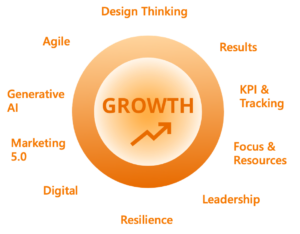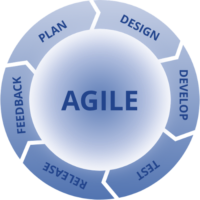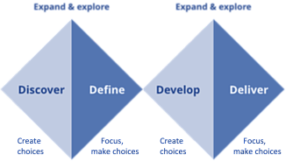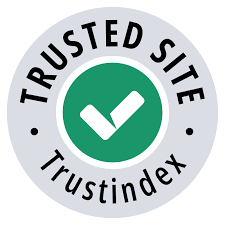Accelerate Growth
The Appleton Greene Corporate Training Program (CTP) for Accelerate Growth is provided by Dr. Fankhauser Certified Learning Provider (CLP). Program Specifications: Monthly cost USD$2,500.00; Monthly Workshops 6 hours; Monthly Support 4 hours; Program Duration 24 months; Program orders subject to ongoing availability.

Personal Profile
Dr. Fankhauser, PhD, is a Certified Learning Provider (CLP) with Appleton Greene. He has a background as an entrepreneur and 25 years of experience, culminating in global senior executive roles in Pharma, Biotech and Medtech. Having led and shaped the global strategy of businesses in healthcare exceeding $12 billion in annual turnover, he is passionate about deep insights into physician and patient needs, smart use of technology to develop and pull through solutions and delivering results and accelerating growth in markets around the world. During his time in industry, his areas of responsibility expanded rapidly from sales and marketing leadership positions in Europe and North America to global executive roles at Roche and Genentech and Shire, where he built global product strategy as a member of the Corporate Executive committee. He led acquisitions, licensing deals and initiatives to accelerate growth through additional indications and profitable geographic expansion. He shaped the global commercial and medical strategy of 20+ brands with sales of >500 million each. As an entrepreneur, he identified, started and grew several small companies in consulting, healthcare and biotechnology. Ueli Fankhauser has hands-on experience in European, North American, Asian and Middle Eastern markets. He is fluent in English, German and French and has conversational skills in Italian and Spanish. He co-founded and co-leads FFI Ventures, a Switzerland-based boutique consulting and digital transformation company working with more than 30 companies in pharma, biotech and medtech. His service skills include business strategy, medical, marketing & sales strategies, digital transformation, agile leadership, effective use of big data, artificial intelligence and generative ai, advanced communications and presentation skills.
To request further information about Dr. Fankhauser through Appleton Greene, please Click Here.
(CLP) Programs
Appleton Greene corporate training programs are all process-driven. They are used as vehicles to implement tangible business processes within clients’ organizations, together with training, support and facilitation during the use of these processes. Corporate training programs are therefore implemented over a sustainable period of time, that is to say, between 1 year (incorporating 12 monthly workshops), and 4 years (incorporating 48 monthly workshops). Your program information guide will specify how long each program takes to complete. Each monthly workshop takes 6 hours to implement and can be undertaken either on the client’s premises, an Appleton Greene serviced office, or online via the internet. This enables clients to implement each part of their business process, before moving onto the next stage of the program and enables employees to plan their study time around their current work commitments. The result is far greater program benefit, over a more sustainable period of time and a significantly improved return on investment.
Appleton Greene uses standard and bespoke corporate training programs as vessels to transfer business process improvement knowledge into the heart of our clients’ organizations. Each individual program focuses upon the implementation of a specific business process, which enables clients to easily quantify their return on investment. There are hundreds of established Appleton Greene corporate training products now available to clients within customer services, e-business, finance, globalization, human resources, information technology, legal, management, marketing and production. It does not matter whether a client’s employees are located within one office, or an unlimited number of international offices, we can still bring them together to learn and implement specific business processes collectively. Our approach to global localization enables us to provide clients with a truly international service with that all important personal touch. Appleton Greene corporate training programs can be provided virtually or locally and they are all unique in that they individually focus upon a specific business function. All (CLP) programs are implemented over a sustainable period of time, usually between 1-4 years, incorporating 12-48 monthly workshops and professional support is consistently provided during this time by qualified learning providers and where appropriate, by Accredited Consultants.
Executive summary
Accelerate Growth
This program accelerates global growth across the Healthcare industry, including pharmaceuticals, biotech and medtech, while enhancing both top and bottom-line performance. The program leverages participants insights into your business and identifies the low hanging fruit that delivers incremental growth in the short term, while laying the foundation for sustained growth focus medium and long term. It engrains a DNA into your organization that focuses on growth and shifts resources in a flexible and rapid way to support and seize growth opportunities. The program builds on combined insights from more than 100 years of leadership in pharmaceutical and biotech companies and work with 5 of the 10 top pharmaceutical companies. It leverages digital channels, tools, and generative artificial intelligence to accelerate and transform the business. More than 25 pharmaceutical and biotech companies have implemented essential elements of this program and improved their business. This program integrates insights and concepts from the tech industry and Marketing 5.0. It leverages agile operating principles embraced and developed by companies such as Amazon and SpaceX to drive growth in a nimble way in today’s disruptive times.

Companies participating in this program can expect to benefit from world leading organizations who have successfully implemented the methodologies. As an example, Genentech applied the growth methodology to individual brands, franchises and across its entire portfolio of brands and was able to identify and prioritize the most attractive growth opportunities and accelerate its expansion. 

This program encompasses the following scope. In year one, we start out by identifying near term growth opportunities and the effort and time required to realize these. Empathizing with key target audiences allowing to gain deep insights that serve to differentiate the approach and find further growth opportunities, also looking beyond the immediate business. Conceptual frameworks such as Design Thinking, Agile, working in Sprints and Scrums, opportunity mapping and prioritization are introduced and applied throughout the program. By identifying stakeholders and the relevant ecosystems, defining the channels and the specific KPIs, initiatives are designed for impact and effective implementation. Close loop tracking sharpens the focus on results tracking and systematic insights generation. Attention is also given to achieving organizational readiness and resourcing, which includes securing the budgets and capacity and putting in place effective tracking methodologies to ensure that objectives are met.

Year two focuses on accelerating momentum with digital, artificial intelligence and generative AI, developing and testing minimum viable projects (MVP) and relying on the 80/20 rule and imperfect information when making decisions. Deeper insights, collaboration, and co-creation with the target audiences to develop innovative solutions and productive external partnering, open the way to additional growth sources. Leveraging tech for a deeper understanding of customer thinking and customer journeys, in particular the pain points that allow your organization to intervene and add value. Understand generative AI and prioritize the use cases that help advance and transform the business during increasingly disruptive times. Accelerate launches of new products and services. Ensure support by an adapted tech stack that allows to scale with a growing organization. Reflect the agile business approach in adapted leadership behaviors to unlock more value and do so faster. Embed a mindset of resilience and growth and equip leaders to scale the growth impact across the organization.
This program is focused on introducing methodologies while delivering rapid results. Participants learn a different way of working while showcasing results and seeing progress with the growth projects that they’ve prioritized. Merging strategy and execution, the program builds the foundation for accelerating growth beyond the initial quick wins. It leverages digital transformation and insights from digital channels and platforms as well as tools for step changes that allow the organization to operate at a different level. This includes the targeted and managed use of artificial intelligence and generative artificial intelligence for very specific use cases with a well-defined scope and risk that support further growth and efficiency gains.
How can this program benefit your organization and your business? It allows you to grow your business and build capabilities that embed and sustain growth in your organization. Building on the work with more than 25 biotech, medtech and pharma companies over the past decade, this program results in significant growth, acceleration of capability development and digital proficiency. It incorporates insights from more than 100 years of experience in executive roles in the industry, shaping company portfolios, franchises, and brand strategies and implementing them successfully. The focus on insights and  real-world business application reflects our philosophy of creating an impact and delivering results. This includes the targeted use of generative AI, where we currently work with five of the top ten pharma companies and all three of the major tech companies with leading edge solutions. In essence, this program accelerates growth of your organization, and it also builds the capability and the capacity to sustain that growth and make it part of the fabric of your organization.
real-world business application reflects our philosophy of creating an impact and delivering results. This includes the targeted use of generative AI, where we currently work with five of the top ten pharma companies and all three of the major tech companies with leading edge solutions. In essence, this program accelerates growth of your organization, and it also builds the capability and the capacity to sustain that growth and make it part of the fabric of your organization.

Use Case Agile Methodology
By embracing Agile concepts, SpaceX is able to function more quickly, cheaply, and effectively. Instead of seeing Agile as a strict technique, they see it as a source of inspiration. By leveraging quick, real-time 3D modeling, the company invests in a process called ‘Design-through-Delivery-Pipeline’, which automates the process of creating, simulating, and delivering gear. This method encourages a speedy, iterative design process by enabling engineers to quickly iterate designs.
The Plan-Do-Check-Act/Adapt cycle, on which Scrum Sprints are built, allows for quick learning and quick adaptation. Rapid feedback cycles reduce risk by identifying errors early and provide opportunities to take advantage of unanticipated ones. Learning occurs more quickly the shorter the cycle. The team is able to go forward, gather input, adjust, and make minor adjustments thanks to this method. The construction of solutions using sets as opposed to points is the second premise. In a conventional project, the design team may be compelled by the milestones to begin working on «the ultimate solution design» at an early stage of the project. It could be quite difficult to change direction if testing and integration later identify design flaws.
SpaceX has a “fail fast” strategy rather than aiming for perfection before beginning construction. It is crucial to be able to proceed directly from design to “print.” At SpaceX, design and simulation play a major role, but they don’t aim to perfect a concept before trying it. In addition to simulating and designing, they frequently build and test. They believe that creating something from scratch and seeing it through to failure teaches them more than a hundred simulations could. The Agile idea of continual improvement through testing and learning is in line with this “hardware-rich” approach. 3D printing makes it possible for designs to change without requiring new tools because it speeds up the process from design to test. They use a “red-green” cycle for development, which enables quick convergence of concepts. SpaceX promotes the reuse of concepts, tools, and techniques. They are innovators in cost reduction, efficiency enhancement, and the development of reusable orbital-class rockets. Their success is attributed to the Agile methodology, which solves smaller issues one at a time before systematizing the entire process.
They use 3D printing technology to lower the cost of producing parts whose design is constantly changing. This allows the design to change over time without requiring the fabrication of new dies—they may simply print a new design. This is crucial because it makes possible the “red-green” cycle of development, which is essential to an agile methodology. It permits quick changes to the design. A design converges on perfection considerably more quickly when it is tested often rather than waiting to be perfect through analysis. This is because there is no need to wait for a design to be perfect before attempting to implement it. The design is constantly evolving as a result of this process, therefore if someone from SpaceX is asked about the present design, their response may alter from one month later. Although it may appear disorganized to an outsider, this is a typical feature of an Agile and evolutionary design process.
For instance, SpaceX has entirely redesigned its proposed Mars vehicle. Initially, they planned to send a crew capsule to Mars using their Falcon Heavy vehicle; later, they changed their mind and came up with the concept of the “Starship.” After switching from using a carbon fiber shell to one made of stainless steel, SpaceX was able to create its first prototype test vehicle for the Starship a few months after the original plans were made. A program would be years behind schedule if a significant design change were made using conventional procedures since the new design would need to be meticulously simulated and confirmed before a flawless prototype could be built. However, SpaceX does not anticipate that its prototypes will function flawlessly, if at all. The Starship prototype they constructed was destroyed during testing, and according to SpaceX, it was precisely the purpose of the prototype: to test the concept and push the envelope.
From SpaceX to Amazon, Spotify, Google, Netflix, Bosch, Saab, SAP, Salesforce, Riot Games, and Tesla, the most successful businesses aim to combine agile teams and conventional structures. Four key areas must be supported for these operating principles to be implemented effectively in order to integrate Agile throughout the organization:
1. Values and principles, especially core leadership values, must complement the needs of dynamic, agile teams.
2. To effectively collaborate with an agile business, operating structures of IT systems and processes as well as more conventional support services like HR, finance, and facilities must be modified.
3. To attract and retain leaders who are accustomed to working in this setting, it is imperative that talent acquisition and key member incentive align with the dynamic nature of the workplace.
4. As the company grows more dynamic, event-driven funding with choices replaces set annual budget reviews. This is similar to how venture capital opens up funds for new businesses.
In conclusion, SpaceX has demonstrated a consistent application of Agile across teams and functions, all the while preserving a methodical strategy of ongoing iteration toward a grand and ambitious goal—all without making Agile into a religion. This enables the business to make very real progress toward its goal while quickly adapting to a changing environment.
![]()
Use Case Drive for innovation
Since its founding in the early 1900s, 3M—formerly known as The Minnesota Mining and Manufacturing Company—has experienced a significant metamorphosis. Their creative strategy is based on a significant emphasis on teamwork, efficient procedures, and employee engagement. Through its innovation program, 3M continuously provides a wide range of opportunities with the help of multiple Innovation Centers and Technical forums.
70% on Core Innovation: 3M prioritizes improving its current technology and products, with particular attention to markets including electronics, transportation, and healthcare. The organization allocates substantial resources towards research and development (R&D) with the objective of achieving gradual enhancements that sustain its competitive edge and provide customers with improved products. For instance, in order to satisfy the changing demands of many industries, 3M consistently enhances its films, adhesives, and abrasives.
20% on Adjacent Innovation: 3M aggressively investigates prospects in neighboring markets and technologies in an effort to diversify, frequently through alliances or strategic acquisitions. The corporation is able to expand into new areas and diversify its product line thanks to this strategy. The purchase of Acelity, a well-known provider of wound care and regenerative medicine, and the partnership with ON Semiconductor to create state-of-the-art automotive sensing technologies are two prime examples.
10% on Disruptive Innovation: 3M devotes resources to long-term disruptive technologies because it understands their potential to completely transform markets or industries. The company’s innovation culture has produced ground-breaking products that have revolutionized their respective sectors, such as the indispensable N95 respirator and the recognizable Post-it Note.
By adhering to the 70/20/10 rule of innovation, 3M has demonstrated its ability to adapt and change from its beginnings as a mining and manufacturing company to become a global force recognized for its ground-breaking innovations and breakthroughs in a variety of industries. One of the key elements of 3M’s innovation process is their “15% rule”, encouraging employees to spend 15% of their time working on projects outside their regular job duties.
Curriculum
Accelerate Growth – Part 1- Year 1
- Part 1 Month 1 Accelerate Growth
- Part 1 Month 2 Stakeholder Ecosystem
- Part 1 Month 3 Quick Wins
- Part 1 Month 4 Agile Framework
- Part 1 Month 5 Deep Insights
- Part 1 Month 6 Market Competitors
- Part 1 Month 7 Near-Term Opportunities
- Part 1 Month 8 Prioritize Opportunities
- Part 1 Month 9 Secure Resources
- Part 1 Month 10 Ensure Readiness
- Part 1 Month 11 Scale Delivery
- Part 1 Month 12 Elevate Perspective
Accelerate Growth – Part 2 – Year 2
- Part 2 Month 1 Technology Capabilities
- Part 2 Month 2 CX Transformation
- Part 2 Month 3 Collaborative Innovation
- Part 2 Month 4 Tech Insights
- Part 2 Month 5 Personalized Engagement
- Part 2 Month 6 Generative AI
- Part 2 Month 7 Agile Leadership
- Part 2 Month 8 Differentiating Tech
- Part 2 Month 9 Adaptive Allocation
- Part 2 Month 10 Agile Marketing
- Part 2 Month 11 Resilience Mindset
- Part 2 Month 12 Scale Impact
Program Objectives
The following list represents the Key Program Objectives (KPO) for the Appleton Greene Accelerate Growth corporate training program.
Accelerate Growth – Part 1 – Year 1
Part 1 focuses on putting in place the conceptual framework to accelerate growth, all while delivering results and learnings.
- Part 1 Month 1 Accelerate Growth – The goal of this module is to assist in identifying market and organizational growth drivers and barriers. Select the dominant strategy to follow by starting with the basic options of pursuing distinctiveness or expanding the market. Use technology to break through into new markets, develop new ones, or change ones that already exist thanks to innovative solutions or service integrations that connect existing markets and forge new ones. This strategy has been successfully used by businesses like Genentech to pinpoint and rank expansion prospects for particular brands, franchises, and the company as a whole. Based on the belief that every firm possesses important market insights that may be leveraged to accelerate growth, several avenues for prospective growth are methodically identified and examined. In order to obtain insights into the changing expectations of users and strategies for enhancing their customer experience, we also analyze how the newest technology and information that is readily available to the public are used intelligently. The practical introduction to the Stanford School of Design’s Design Thinking methodology is also included in this subject. The five steps of empathy, definition, ideation, prototyping, and testing are taught to participants. This approach is regularly used by cutting-edge healthcare and IT organizations to generate novel ideas and test them quickly, spurring growth. We establish a strong foundation because this framework will be used throughout the program. This helps create an initial growth opportunity map, concentrating on prospects with short-term effects and low resource requirements. Consequently, this module produces an initial roster of prospective expansion prospects, arranged based on various standards that correspond to the organization’s aims.
- Part 1 Month 2 Stakeholder Ecosystem – Identify the internal and external players who have the power to either facilitate or obstruct growth prospects. Using structured brainstorming, one can list the important external influencers as well as the internal decision-makers and investment decision-influencers. Verify internal data sources, such as earlier initiatives and market research. Make sure you have an external viewpoint by using information from digital channels and secondary sources. Identify the main goals and arrange the stakeholders according to the degree of significance, reachability, and impact each has over the goals. If necessary, factor in the time it will take to contact stakeholders and encourage them to take action. Determine how the phasing and the many stakeholders may work together. Make a map of the ecosystem and rank the engagement opportunities and pain points according to predicted return on effort. Set group priorities and create an engagement plan with important messages and your preferred means of communication. To help the business, describe and map the internal digital and supply environment. Determine the rate-limiting variables and the work needed to increase limits and go past obstacles. Establish KPIs to aid in the accomplishment of goals and make clear the procedures and systems needed to monitor them in order to facilitate quick feedback and prompt action. Combine the insights into an all-inclusive, yet straightforward ecosystem that facilitates quick ideation and solution creation. Utilize a workable mapping framework that has been tried and true by organizations like Bayer and Johnson & Johnson in the areas of specialist care, devices, uncommon diseases, oncology, and broad indications.
- Part 1 Month 3 Quick Wins – Promote a balanced approach to innovation by allocating resources to core, adjacent, and transformational activities by utilizing Google’s 70/20/10 guideline. By using controlled brainstorming approaches to generate a list of potential customers, participants acquire the skills necessary to recognize these opportunities. In order to ensure that the most significant and practical projects are tackled first, producing early victories and creating momentum, the program also emphasizes the significance of ranking and prioritizing quick win projects. The course teaches participants to design thinking approaches and the Minimum Viable Product (MVP) strategy in order to effectively drive these prospects. These approaches place a strong emphasis on iterative development, which keeps products flexible, user-focused, and ready to change as the healthcare industry does. A key component of this program is aligning the company around relevant metrics and milestones, which allows for exact tracking of learnings and progress. By doing this, people can adjust their plans in light of current information. In addition, the training recognizes the importance of collaborative innovation in the healthcare industry and promotes the search for chances to co-create with patients and healthcare professionals. Ultimately, it tackles the crucial phase of obtaining the required funds to start these initiatives, moving from plan to concrete outcomes. In conclusion, this program gives participants a solid and methodical way to take advantage of growth prospects in the healthcare industry by applying tried-and-true techniques, giving priority to immediate results, and matching tactics to precise performance indicators.
- Part 1 Month 4 Agile Framework – A thorough introduction to the Agile framework and how it may be used in healthcare organizations, with examples from businesses like the global transformation of F. Hoffmann-La Roche. The main tenets of Agile will be well understood by participants, with an emphasis on cooperation and adaptation as the two main forces behind success. One of the core ideas of Agile is stressed in the training: the “Sprint,” which is a time-bound, cross-functional team effort with the goal of completing a predetermined set of tasks. These Sprints are intended to promote quick iteration and solution evolution, which is an essential skill for prospering in the always changing healthcare environment. Moreover, the program incorporates the ‘Scrum’ framework, offering an organized method for implementing Agile. Through the integration of Agile and Scrum concepts, participants will get the necessary tools and approaches to effectively navigate the ever-changing healthcare environment. Identifying how to form teams for maximum success, reducing complexity, and optimizing procedures are important aspects of this training. Frequent feedback sessions are included to guarantee growth acceleration and ongoing improvement. In conclusion, the goal of this program is to equip participants with a strong foundation in Agile techniques so they can take advantage of flexibility and teamwork. Participants will be well-prepared to accept change, simplify their processes, and spur growth by utilizing the Agile and Scrum tenets. Participants are positioned for success in their organizations through the systematic application of Agile, regular feedback, and an emphasis on team dynamics.
- Part 1 Month 5 Deep Insights – Participants in this monthly training session will explore the nuances of deciphering the patient and healthcare professional journey, with an emphasis on identifying critical touchpoints that have the potential to provide significant value for the healthcare ecosystem. During the event, participants will be walked through the process of mapping these trips and identifying crucial contacts that have the potential to have a major impact on both patient outcomes and the efficacy of healthcare overall. The strategic definition of target audiences and pertinent influencers is a key element of this session, which guarantees a comprehensive grasp of the stakeholders who are essential to the patient and healthcare professional experience. Participants will also learn how to successfully use digital platforms and channels to enable quick insights and authenticity in line with the changing healthcare industry. This workshop aims to provide guidance to participants on the most effective ways to use both qualitative and quantitative research to quantify and confirm growth prospects. It draws inspiration from prominent industry figures such as Shire and Takeda. By highlighting the importance of research, participants may ensure that strategies are based on empirical insights by making well-informed, data-backed decisions. This presentation will also introduce the idea of panels, which provide a dynamic way to quickly and efficiently engage the most appropriate target audiences. This approach, which places a strong emphasis on agility and quick turnaround, is in line with the rapidly changing healthcare industry. In conclusion, this monthly training session gives attendees insightful knowledge and practical tools to improve their comprehension of the patient and healthcare professional journey, make use of digital platforms, and apply research methodologies to find and seize opportunities for professional growth in the healthcare industry.
- Part 1 Month 6 Market Competitors – Building on real-world case studies that offer priceless insights, this training program delves deeper into the topic of ecosystem mapping across various therapy areas and marketplaces. These case studies are useful illustrations that shed light on the subtleties and complexities of ecosystem mapping, particularly in various markets and therapy areas. Through the analysis of these scenarios, participants will gain enhanced ability to distinguish between market archetypes according to their distinct requirements and the particular growth prospects they offer. Participants will concentrate on identifying and prioritizing communication routes as the session goes on. Healthcare communication is a dynamic field that includes both digital and analog platforms, each with unique benefits and drawbacks. The goal of this session is to assist participants in making well-informed decisions about the best platforms for communicating with stakeholders, spreading their messages, and spurring market expansion. In addition, the program pushes participants to investigate collaboration opportunities and find possible partners who may enhance their project strategy and organizational structure. In order to effectively address complex difficulties in the healthcare industry, collaboration can be very helpful. This program gives participants the knowledge and abilities to choose and interact with appropriate partners. In conclusion, this training session provides a more thorough grasp of ecosystem mapping by utilizing case studies from various markets and therapy areas to guide participants’ tactics. Participants can customize their approach to the particular requirements of their target audiences by identifying market archetypes and prioritizing communication channels. In the healthcare industry, looking into partnership prospects also increases the likelihood of successful project outcomes and organizational growth.
- Part 1 Month 7 Near-Term Opportunities – Participants in this training will set out on a path of opportunity development in the healthcare industry, an area where creativity and flexibility are critical. This session’s creation of prototypes, which acts as a link between conceptualization and tangible implementation, is one of its main topics. Offering a useful approach to innovation, participants will be guided to develop prototypes that target both short- and long-term prospects. This workshop is unique in that it encourages participants to investigate both conventional and non-conventional approaches of market engagement. Embracing unusual approaches can often be the key to unlocking new prospects in a dynamic business such as healthcare. Participants are prepared to make judgments based on the particulars of their projects and target markets by carefully analyzing both strategies. The Minimum Viable Product (MVP) approach is a methodology that has shown to be quite beneficial in the healthcare setting, and it is heavily stressed in this session. MVP is a potent instrument for cutting down on the amount of time needed to see new initiatives through to completion. It maximizes the distribution of resources, a crucial factor in the healthcare industry where economy and effectiveness are paramount. By emphasizing quick feedback and validation and guaranteeing that solutions are adaptable, user-centric, and continuously enhanced based on real-world observations, the MVP approach also reduces risks. The seminar also emphasizes how important risk mitigation is to the healthcare industry, considering the different interests of stakeholders and the industry’s strict laws. Participants will be better able to handle these complications if they use the MVP technique. This method encourages a culture of flexibility and nimbleness, where invention is quickly transformed into concrete prototypes rather than remaining in theoretical conversations. In summary, this course equips participants with the skills necessary to transform healthcare prospects into workable prototypes by applying the MVP technique to maximize resource allocation, shorten time to realization, and successfully manage risks. In this dynamic business, this workshop gives healthcare workers the tools they need to make real, concrete changes by promoting hands-on innovation and offering useful resources.
- Part 1 Month 8 Prioritize Opportunities – During this training session, participants will explore the critical process of prioritizing and mapping opportunities in the healthcare sector by choosing and using basic assessment criteria. This workshop, which builds on best practices from mid- and large-sized pharmaceutical companies, gives participants a structured method for assessing possibilities according to important criteria like size, amount of work needed to realize the opportunity, and time element. The development of a strategy roadmap that directs participants in their search for the most attractive prospects depends on these assessment criteria. In addition, the program helps participants uncover important internal gaps in their businesses, going beyond just prioritizing and identifying opportunities. To make sure that participants have the internal resources and know-how to take advantage of the opportunities they have found, this introspective investigation is crucial. The course places a strong emphasis on the value of approaching opportunity development holistically, accounting for both internal and external variables. Participants will also learn more about how to find and work with partners that can provide the additional knowledge and resources that are required. Partnerships can play a crucial role in bridging gaps and guaranteeing the successful realization of prospects in the dynamic and complicated healthcare sector. In order to match partners’ competencies with the goals of the organization, this session offers a strategic framework for finding and interacting with the appropriate partners. Another important part of opportunity development that is emphasized in the training is the necessity to strike a balance between the accuracy and rigor of forecasts and projections. For well-informed decision-making, resource allocation, and risk management, accurate forecasting is essential. In order to guarantee that investments are in line with strategic goals and that resources are distributed effectively, participants will gain knowledge on how to set trigger conditions for financing.
- Part 1 Month 9 Secure Resources – This training course covers benchmarking in addition to opportunity identification and development to make sure healthcare businesses get a crucial voice in their competitive environment. In order to ascertain whether their share of voice is sufficient, participants will get knowledge on how to assess and contrast their expenditure levels with those of their industry peers. In the healthcare industry, where good stakeholder involvement and communication may make a big difference in project and initiative success, this share of voice is essential. Additionally, the session instructs participants in triangulation, an approach that validates underlying assumptions by using significant analogs inside the treatment area or by relying on business similarity. Participants can make necessary adjustments to their strategies and make sure their assumptions are in line with industry realities by making comparisons with similar circumstances or firms. Triangulation is a successful risk-reduction strategy that helps participants make data-driven decisions and improves the precision of their forecasts. A crucial part of this session is determining the resources to request and the capacities that are required. Having the proper resources at the right time can make all the difference in the fast-paced healthcare sector. In order to make sure that their projects get the resources and support they need to succeed, participants will learn how to assess their requirements and interact with the relevant stakeholders. This presentation also highlights the need of optimizing resource demands in a way that aligns with company requirements and values. Resource requests that are in line with these fundamental values promote an environment of openness, accountability, and effective resource allocation while guaranteeing the accomplishment of the organization’s strategic goals. To summarize, this training session provides participants with the necessary information and tools to ensure a significant voice is heard, verify assumptions, recognize capabilities and resources, and efficiently optimize resource requirements.
- Part 1 Month 10 Ensure Readiness – Participants will leave this training session with a thorough understanding of the essential components of internal organizational preparation. The ability to execute change, adaptability, resource allocation, knowledge, cultural fit, support and alignment from the leadership, and efficient use of communication channels are some of these essential elements. By taking a comprehensive strategy, healthcare companies can be confident they are ready to take on projects that will change their industry and create a culture of adaptation and readiness. This session’s emphasis on mapping important external partners who are critical to the project’s success is a critical component. The ability to recognize these outside partners and fill in any preparation deficiencies will be imparted to the participants. Strategic alliances are frequently essential in the ever-changing healthcare environment for handling complexity and guaranteeing project success. Through the process of locating and interacting with appropriate external partners, participants can enhance their preparedness for a project’s successful completion. Insights into creating and monitoring a basic readiness dashboard for enterprises will also be shared during the session. This dashboard provides insight into the different aspects of preparation, allowing for prompt action as needed. Organizations can proactively handle any difficulties or obstacles that may develop by having the capacity to monitor and assess readiness at a glance. This helps to ensure that projects stay on track and correspond with strategic objectives. This all-encompassing strategy encourages a mindset of readiness and flexibility, which is critical in the constantly changing healthcare environment, and equips participants to successfully negotiate the industry’s intricacies.
- Part 1 Month 11 Scale Delivery – A key component of ensuring the success of healthcare projects is the mobilization of the core team, which is heavily emphasized in this training session. Participants will gain knowledge on how to put together a core group of individuals who are competent and in line with the project’s aims and objectives. Organizations can create the conditions for a project’s successful completion by making sure the core team is unified and well-prepared. Creating a targeted and useful dashboard is yet another important aspect of this meeting. Participants will learn how to design a dashboard that offers a succinct and understandable summary of the status of the project. Real-time tracking and assessment are possible with this dashboard, facilitating prompt decision-making and interventions. Organizations may stay on track with their projects and retain visibility into them by implementing a well-designed dashboard. In addition, the workshop directs participants in allocating resources according to anticipated performance. Effective resource allocation guarantees that funds are directed toward projects that offer both short- and long-term growth. This strategy fosters an efficient and goal-oriented execution culture while optimizing resource allocation. One cannot stress how crucial it is to develop success definitions cooperatively with the core team. Organizations and teams can maintain alignment with their goals and guarantee that resources are consistently directed toward growth-promoting projects by establishing unambiguous success criteria. Participants will also have the ability to recognize important lessons from quick win projects and apply these insightful discoveries to improve project design. Rapid victories offer valuable insights that can be integrated into project plans, enhancing the probability of project success.
- Part 1 Month 12 Elevate Perspective – Participants in this course will learn the tremendous benefits of standing back, broadening their viewpoint, and assessing possibilities and advancement from an elevated position. Healthcare personnel are able to evaluate their projects in the context of the industry as a whole and have a comprehensive grasp of them thanks to this strategic perspective. They can then determine which components have the capacity to propel them to the following S-shaped growth curve by doing this. Organizations are encouraged by this method to look beyond the near future and aim for long-term, revolutionary growth. By assisting participants in identifying prediction models, the session goes one step further. These models play a critical role in predicting results and helping organizations set priorities for initiatives throughout the experimental phase. Participants may make data-driven decisions and guarantee that the most promising growth possibilities get the resources and attention they deserve by utilizing predictive models. This method fits with the dynamic nature of the healthcare industry and expedites the conception to realization process. It also simplifies the development of projects. The need of ongoing assessment and adjustment based on predictive insights is also emphasized throughout the workshop. Healthcare companies will gain the ability to stay flexible and adjust to new trends and changes in the market. They may stay ahead of the curve and preserve a competitive advantage by incorporating predictive models into their strategic planning.
Accelerate Growth – Part 2 – Year 2
Part 2 builds on the hands-on experience learned in Part 1 and broadens the perspective to include organizational capabilities, embracing tech and leveraging ai technologies to accelerate growth.
- Part 2 Month 1 Technology Capabilities – Healthcare workers have a priceless opportunity to broaden their perspectives during this training session, especially with regard to potential for digital transformation. The ever-changing healthcare sector necessitates constant innovation, and this event gives attendees the skills and information they need to recognize and take advantage of game-changing digital opportunities. Through an examination of the outcomes of quick win projects, participants can derive important insights pertaining to goals, KPIs, systems, and techniques employed. These observations provide a useful starting point for enhancing and streamlining digital strategy. In addition, the workshop makes use of the practical knowledge of multiple healthcare companies, utilizing actual situations to pinpoint organizational growth avenues. The healthcare industry is distinct, with every organization having its own culture and set of problems. Through the integration of these varied viewpoints, attendees will acquire a thorough comprehension of the several routes leading to organizational development. This strategy promotes an innovative and practical culture of continual improvement, which is in line with the practical and flexible nature of the healthcare industry. The capacity to take advantage of insights, prospects for digital transformation, and organizational development routes is critical in this dynamic business. Upon completion of this training session, healthcare workers will possess the necessary information and abilities to efficiently navigate the complicated healthcare landscape. Through introspection on practical experiences and integration of optimal methodologies, participants can formulate approaches that propel digital transformation and organizational expansion, guaranteeing their sustained leadership in innovation and flexibility amidst the constantly changing and dynamic healthcare sector. This strategy puts them in a successful position by encouraging the kind of innovation and constant development that is crucial in the healthcare industry.
- Part 2 Month 2 CX Transformation – Participants gain a deeper understanding of customer journey mapping and the customer experience (CX), especially with regard to important segments. Participants can obtain deep insights into the requirements and expectations of their clients by practicing empathic design. The presentation emphasizes the advantages of providing smooth customer service throughout the customer journey, which in turn improves satisfaction and fosters brand and company loyalty. Scenarios from a number of top Pharma and Biotech companies provide compelling case studies that show how Agile approaches may transform the customer experience. These companies have increased customer loyalty and satisfied customers by implementing quick iteration and continual development. These illustrations offer concrete proof of the beneficial effects that an adaptable and customer-focused strategy may have on the healthcare sector. The workshop also helps participants define the parameters for optimizing the customer experience by using case studies from several fiercely competitive rare illness environments. This empirical investigation highlights the distinct obstacles and prospects brought about by diverse healthcare environments. Healthcare workers may create plans that are in line with industry reality and make better judgments by knowing the constraints and limitations that surround customer experience optimization. A thorough understanding of customer journey mapping, sympathetic design, and the advantages of seamless interactions are provided in this webinar. Participants may transform the customer experience and increase satisfaction and loyalty by using Agile approaches and looking at real-life examples from experts in the field. Furthermore, by examining limits in fiercely competitive rare disease environments, participants gain a deeper understanding of the subtleties and complexity of the healthcare industry. By providing professionals with the tools they need to successfully manage these possibilities and obstacles, this session helps the healthcare industry develop a culture of innovation and customer-centricity.
- Part 2 Month 3 Collaborative Innovation – Participants are encouraged to investigate the many organizational configurations seen in the biotechnology and pharmaceutical industries during this session, with a focus on how project teams and functions are balanced. In order to find the ideal balance, different firms in this industry use different strategies, each with specific benefits and possible drawbacks. Through examining case studies from midrange and small biotech companies, as well as five of the top ten pharmaceutical companies, participants learn about the implications of these organizational decisions for accelerating cross-functional growth. An in-depth grasp of how different organizational structures affect project execution and cross-functional collaboration is provided by this investigation of organizational configurations. The case studies provide insightful real-world illustrations that highlight the challenges of striking a balance between project teams and organizational roles. In addition, participants will get an understanding of the advantages and disadvantages of various organizational options, enabling them to make well-informed judgments regarding their own organizational structures. Marketing and medical managers at pharmaceutical and biotech businesses can better traverse the complexities of their industry by considering the implications of these decisions for cross-functional growth acceleration. All things considered, this session provides a thorough analysis of the various organizational structures found in the biotechnology and pharmaceutical sectors. By utilizing authentic case studies, attendees acquire a more profound comprehension of the consequences associated with these decisions for accelerating cross-functional growth. Marketing and medical managers can make informed judgments about their own organizational structures and promote a culture of innovation and adaptation within their companies by examining the advantages and potential drawbacks.
- Part 2 Month 4 Tech Insights – In the pharmaceutical and biotechnology industries, advanced data analytics, machine learning, and AI-driven insights are revolutionary instruments that may greatly enhance strategic decision-making. During this event, attendees will learn how to use these cutting-edge technologies to make quick, well-informed decisions. The participants will be able to extract actionable insights that drive growth by utilizing Agile concepts in their data analysis. Through the use of continuous feedback loops and iterative learning, this approach makes sure that the insights are continuously improved and optimized to meet organizational goals. In-depth case studies from real-world experiences working with different MedTech and Biotech companies provide insightful information for this session. These practical examples show how industry difficulties may be successfully addressed with advanced data analytics, machine learning, and AI-driven insights. By observing firsthand how these technologies affect strategic decision-making, participants will be able to confirm the usefulness and efficiency of these instruments in the biotechnology and pharmaceutical industries. Participants will also investigate how these technologies might inspire creativity and flexibility in their companies. The seminar promotes a proactive mindset, enabling medical managers and healthcare marketers to use data-driven insights to make strategic decisions that are in line with changing market dynamics and industry realities. To sum up, this session provides a thorough examination of how AI-driven insights, machine learning, and sophisticated data analytics may transform strategic decision-making in the biotechnology and pharmaceutical sectors. Marketing and medical managers can leverage the potential of these technologies to spur growth and innovation by implementing Agile concepts in data analysis and leveraging actionable insights from real initiatives. Their proactive stance equips them to adeptly handle the intricacies of the market, cultivating a climate of flexibility and well-informed judgment in their own businesses.
- Part 2 Month 5 Personalized Engagement – Whether you call it “segment of 1” or “white glove service,” patients and healthcare providers in the era of personalized healthcare have one clear expectation: they want to be acknowledged and treated as unique individuals. This seminar explores the revolutionary trend of individualized care and how the biotechnology and pharmaceutical industries will be affected by it. Through insightful case studies of a rare illness leader and a specialty pharmaceutical company, participants will learn about the real-world implementation of individualized care in both settings. This course will focus on the strong tool of psychographic and behavioral segmentation, which allows for the identification of discrete groups with varying requirements and priorities. Organizations can customize their engagement tactics to meet the specific preferences of these patient and healthcare professional segments by having a thorough awareness of their nuances. The talk emphasizes how technology plays a critical role in enabling more focused and customized interaction, which eventually produces amazing outcomes. Additionally, this session promotes a forward-thinking strategy, putting medical administrators and healthcare marketers in a position to use individualized care to their organizations’ advantage. Participants may effectively manage the change towards individualized care by utilizing the insights from these case studies and implementing psychographic and behavioral segmentation. This will promote a culture of flexibility and innovation within the pharmaceutical and biotechnology sector. In conclusion, this session provides a thorough examination of customized care in the biotechnology and pharmaceutical sectors. Marketing and medical management can learn a great deal about the real-world applications of behavioral and psychographic segmentation, individualized treatment, and the enabling role of technology by using real-world case studies. By preparing people to fulfill the demands of patients and healthcare professionals, this proactive approach promotes a culture of innovation and adaptability inside their individual organizations.
- Part 2 Month 6 Generative AI – This presentation provides a deep dive into the revolutionary potential of AI technology within the pharmaceutical and biotechnology business, including real-life lessons from various generative AI initiatives in conjunction with four of the top 10 pharmaceutical corporations. Participants will examine the areas where generative AI offers the rare chance to collect real-time customer insights data and quickly unlock significant value. By adding a dynamic and flexible component to strategic decision-making, this method guarantees that businesses stay ahead of the curve in terms of market developments. This presentation will clarify the situations in which generative AI can be used successfully, even in the pharmaceutical industry, which is known for its strict compliance and legal standards. Participants will acquire insights about how businesses have negotiated the regulatory environment while utilizing AI technology by looking at actual cases. This investigation supports the industry’s use of AI-driven solutions’ adaptability and pragmatism. Additionally, by encouraging a forward-thinking mindset, this workshop positions medical management and healthcare marketers to accept AI technology as a strategic advantage. Through assiduously analyzing the outcomes of generative AI initiatives and pinpointing the precise fields in which AI might yield expeditious benefits, participants can foster an environment of flexibility and ingenuity in their individual enterprises. Their proactive approach enables them to fully utilize AI, even when adhering to regulatory and legal obligations. In conclusion, this session offers a thorough overview of the revolutionary potential of generative AI in the biotechnology and pharmaceutical sectors. Through the utilization of real-world projects with top pharmaceutical businesses, participants acquire a sophisticated comprehension of the appropriate applications and scenarios for generative AI. This proactive strategy gives medical and marketing professionals the know-how and tactics to quickly create value while meeting regulatory and compliance obligations, encouraging a flexible and innovative culture inside their companies.
- Part 2 Month 7 Agile Leadership – It’s critical to recognize and understand the complex demands placed on growth leaders in the field of healthcare leadership. This workshop sheds light on the vital significance of improving patient outcomes and tackling the various obstacles present in the healthcare system. Pharmaceutical and biotech businesses’ marketing and medical management will learn more about the challenges of balancing growth objectives with patient well-being. The focus on team empowerment and cross-functional collaboration is central to this workshop. Participants will investigate how to balance innovation and risk management in empowered teams that iteratively improve procedures and react quickly to the constantly changing healthcare environment. Case studies from a range of MedTech and Pharma firms support this strategy by providing real-world examples of how various organizational cultures and transformation programs have been successful in generating value. Marketing and medical managers can learn more about the tactics and best practices that promote expansion while reducing obstacles by looking at these real-world examples. Nonetheless, the workshop does not sugarcoat the challenges faced in the quest to maximize value and improve patient outcomes. Through an examination of the obstacles encountered by organizations during their transformational endeavors, attendees can cultivate a pragmatic and knowledgeable perspective regarding their own roles and responsibilities within the pharmaceutical and biotechnology industry. In conclusion, this course gives medical managers and healthcare marketers a thorough understanding of the responsibilities, opportunities, and challenges that come with their jobs. Through a focus on empowered teams, cross-functional collaboration, and innovation, participants get the tools necessary to propel growth and improve patient outcomes. The analysis of case studies by prominent figures in the sector bolsters the applicability of these strategies and provides insightful information about the intricacies of the healthcare environment. This proactive strategy puts marketing and medical managers in a position to successfully traverse the market and promote an innovative and flexible culture within their respective organizations.
- Part 2 Month 8 Differentiating Tech – Technology solutions yield data for consumer insights and personalization integration, as well as real-time analytics. Marketing and medical management in pharmaceutical and biotech businesses can effectively drive growth by cultivating an agile and responsive tech environment. Building and automating for efficiency inside the IT stack requires collaboration between marketing teams and partners in IT delivery. By including tools for collaboration and experimentation, participants will learn how to promote a continuous optimization culture. By using this strategy, the IT stack is guaranteed to continue adapting to changing organizational requirements and market dynamics. This webinar also covers the significance of integrating CRM systems with the tech stack while negotiating the challenging landscape of conflicting regulations and data security. Marketing and medical managers can establish trust with their audiences and guarantee adherence to industry standards by providing a smooth client experience. In conclusion, this session provides a thorough overview of building a technology stack that facilitates the expansion of Agile marketing firms in the biotechnology and pharmaceutical sectors. Participants may promote expansion while centralizing data for real-time analytics and personalization by emphasizing scalability, flexibility, and seamless integration. The approach’s practicality and adaptability are reinforced by its emphasis on collaboration and continual optimization, which equips marketing and medical managers to efficiently negotiate the industry’s intricacies. This forward-thinking approach encourages an innovative and flexible culture in their own businesses.
- Part 2 Month 9 Adaptive Allocation – To enable an Agile customer-facing organization, flexible resource allocation must be implemented effectively. This webinar explores the critical elements that lead to the effective implementation of this strategy. Participants receive insights into effective resource allocation by emphasizing the value of cross-functional teams, explicit prioritizing based on corporate goals and market dynamics, and iterative planning. Pharmaceutical and biotech firms’ marketing and medical management can react quickly to opportunities and problems in the sector by using these techniques. The process of allocating resources relies heavily on data-driven judgments, which guarantee that choices are grounded in practical knowledge. Participants learn how to maximize resource allocation while preserving the wellbeing of their teams by implementing flexible workflows and capacity management to avoid burnout. The importance of scenario planning with backup plans, open communication, aligning stakeholders, and applying Agile frameworks are all emphasized in this talk. Together, these elements help the business develop a culture of flexibility, creativity, and ongoing learning. The workshop also emphasizes how important governance and incentives are to the successful implementation of flexible resource allocation. Organizations can make sure that resources are directed to the areas where they have the most impact on growth by implementing the appropriate structures and incentives. Case studies are real-world observations from a top-5 global pharmaceutical firm that provide useful illustrations of how these ideas have been implemented. In conclusion, this training gives medical and marketing managers at biotech and pharmaceutical businesses a thorough understanding of the concepts and tactics that support adaptive resource allocation. Through a focus on cross-functional teams, data-driven decision-making, and an ongoing learning culture, participants gain the ability to allocate resources optimally and effectively adapt to changes in the market. The utilization of case studies serves to bolster the applicability of these strategies by providing insightful information on the intricacies involved in resource distribution within the biotechnology and pharmaceutical industries. This proactive strategy puts marketing and medical managers in a position to successfully traverse the market and promote an innovative and flexible culture within their respective organizations.
- Part 2 Month 10 Agile Marketing – A few essential components are needed for the strategic approach to medical management and healthcare marketing in order to effectively drive growth in a time of changing market dynamics. The essential elements of effective campaigns in the biotechnology and pharmaceutical industries are dissected in this session. Through the emphasis on customer-centric campaigns that are iterative and driven by data-driven insights, participants are better prepared to manage the intricacies of a fast changing sector. A key component of this strategy is cross-functional cooperation, with teams from market access, medicine, and commerce collaborating to maximize client acquisition and retention. In the end, this collaborative attitude guarantees a comprehensive understanding of the requirements and preferences of the consumer, improving the customer experience and encouraging loyalty. The discussion also emphasizes how important it is to quickly adjust to shifting market conditions. Marketing and medical managers are well-positioned to stay flexible and adaptable to changes in the industry because they place a high priority on rapid time-to-market and ongoing improvement. This strategy necessitates the development of a test-and-learn culture that views both achievements and setbacks as teaching moments, ultimately fostering an innovative and adaptive culture. Case studies from this session’s real-world implementation of these methods in some of the top ten MedTech and pharma businesses are presented. These illustrations provide real-world proof of how the essential components can be successfully used in the biotechnology and pharmaceutical sectors. In conclusion, this workshop gives medical and marketing professionals a thorough understanding of the fundamental elements of successful campaigns within the pharmaceutical and biotechnology industries. By placing a high value on customer-centricity, cross-functional cooperation, and flexible resource management, participants set themselves up for growth via improved customer acquisition and retention. The utilization of case studies serves to bolster the pragmatic and flexible nature of these methodologies, providing insightful perspectives into the intricacies of the healthcare domain. This proactive strategy puts marketing and medical managers in a position to successfully traverse the market and promote an innovative and flexible culture within their respective organizations.
- Part 2 Month 11 Resilience Mindset – Organizations that prioritize learning and rapid growth understand how critical it is to develop resilience and a growth mindset when faced with challenges. This seminar explores the tactics that support growth mindsets and resilience in organizations, especially in the biotechnology and pharmaceutical industries. Leadership is essential in demonstrating these ideas because it openly shares setbacks and opportunities for development. Leaders establish the tone for an organizational culture that values learning and adaptation by modeling vulnerability and authenticity. Another crucial component is a culture of empowerment and ongoing learning. Companies that support innovation and employee ownership foster a culture where people feel encouraged to share their ideas and spur development. This culture naturally encourages learning from mistakes, which helps firms hone their tactics and maintain their adaptability in the face of difficulties. In order to promote resilience, motivation and teamwork are equally essential. Organizations can create a feeling of drive and purpose among their members by defining clear goals and milestones and acknowledging accomplishments. Additionally, recognizing those who exhibit resilience and providing adaptability training strengthen the organization’s capacity to overcome adversity. In particular, leaders are essential in changing the emphasis from celebrating results only to valuing learning and development. They serve as an example for the entire company by sharing their successes, welcoming criticism, and thinking critically about how to improve over time. Insights into the practical application of these concepts are provided, and participants are assisted in understanding potential obstacles to successful implementation through the use of case studies from various Pharma and MedTech companies. To put it briefly, this course gives managers in the marketing and medical fields a thorough understanding of how to cultivate resilience and a growth mentality within their respective firms. Participants are prepared to effectively traverse adversity by placing an emphasis on leadership transparency, a culture of continuous learning, empowerment, adaptation, and teamwork. The utilisation of case studies serves to bolster the pragmatic and flexible nature of these methodologies, providing insightful perspectives into the intricacies of the healthcare domain. This proactive strategy puts marketing and medical managers in a position to foster an innovative and flexible culture within their respective organizations.
- Part 2 Month 12 Scale Impact – It’s critical to see growth efforts as a chance for introspection and change in order to leverage the growth impact within biotechnology and pharmaceutical companies. The impact of scaling growth is examined in this session, taking into account the professional and personal development of industry leaders. Through the use of growth initiatives as a contemplative tool, participants are able to pinpoint opportunities to increase their influence and support the development of future leaders. Creating a platform that allows up-and-coming leaders to increase their influence is a crucial component of this strategy. Finding and developing these people is essential to creating a leadership pipeline that can spur innovation and growth inside the company. Participants will also discover how to take the company’s external alliances and customer-facing departments to the next level internally. This all-encompassing viewpoint guarantees that expansion endeavors are thorough and in line with corporate goals. Feedback loops are essential to the effort to scale growth effects. Through the use of feedback and learning methods, businesses can make ongoing improvements to their strategies and approaches. Another driving concept in this process is simplification, which makes sure organizational activities stay effective and customer-focused. In the end, the scaling growth impact is guided by the customer experience as the North Star. Organizations can provide value and produce significant results by centering growth plans around the needs of the customer. In conclusion, this training gives medical and marketing managers in biotech and pharmaceutical firms a thorough understanding of how to scale growth impact. Participants get the ability to recognize potential growth leaders and establish a foundation for their progress by thinking back on both organizational and personal growth. The focus of the discussion is on how to grow the company in customer-facing roles and outside alliances while keeping a customer-centric and feedback-driven mindset. With an eye on the future, marketing and medical managers may effectively promote growth and innovation within their respective companies and cultivate a customer-centric and adaptable culture.
Methodology
Accelerate Growth
Program planning
The 24-month healthcare sector growth curriculum is precisely created to educate pharmaceutical and biotech marketing and medical managers with a comprehensive toolset of strategies and approaches. Part 1 of the program covers the essentials of growth acceleration.
The program starts by identifying organizational and market growth accelerators and inhibitors. In this stage, consumer expectations for the customer experience are stressed and the Design Thinking framework is introduced to prioritize and pursue growth prospects. Stakeholder and ecosystem mapping follows, teaching participants to identify and prioritize external and internal stakeholders. This practical foundation is based on Johnson & Johnson and Bayer testing, assuring its efficacy.
Through Google’s 70/20/10 rule, the program emphasizes design thinking, minimum viable product, and quick wins. The organization must align on goals and milestones and identify co-creation possibilities with patients and healthcare professionals.
The Agile framework, crucial to healthcare, is also examined in Part 1. Participants learn Agile implementation and rapid iteration and solution evolution using F. Hoffmann-La Roche’s worldwide transformation. The next steps use digital channels and platforms for insights, competitive landscape research, ecosystem mapping, and prototype development to explore the customer and healthcare professional experience. Prioritizing opportunities, internal readiness, and resource security are also covered.
Part 2 extends on Part 1’s practical experience to include organizational capabilities, technology integration, and AI’s growth acceleration potential. Data-driven decision-making, iterative learning, and continual feedback loops are key to AI-driven insights. The program also examines customer engagement personalization and AI’s involvement in real-time customer analytics.
The program must also identify and handle organizational issues and growth possibilities. Participants encourage constant learning, innovation, and flexibility. Real-life pharma and MedTech case studies illuminate these organizational features.
Scalability, flexibility, data consolidation for real-time analytics, and customer insights are also important in an Agile marketing organization’s tech stack. Build automation, teamwork, and experimentation skills with practical advice.
Flexible, data-driven resource allocation is key. Participants learn about cross-functional teams, scenario planning, and capacity management for resource allocation. Encourage continual learning to use resources where they will most benefit growth.
The session concludes by discussing Agile marketing’s benefits in client acquisition, including iterative, customer-centric campaigns, cross-functional collaboration, rapid market adaptability, and a test-and-learn culture. To attract and retain customers, personalized experiences are promoted. The program closes with resilience and growth mentality throughout hardship. Leadership, learning culture, and adaptation training are essential. Also stressed are applauding triumphs and moving the focus from outcomes to learning and growth.
For pharmaceutical and biotech marketing and medical managers, the 24-month training is comprehensive. It gives healthcare professionals a variety of methods to boost growth and innovation. The program’s practical approach, real-world case studies, and sophisticated technologies give participants a solid basis to succeed and impact their businesses and the industry.

Program Development
In order to ensure that this training program is extremely effective, engaging, and customized to the unique requirements of various pharmaceutical and medtech firms, the following steps will be taken to optimize its development:
• Comprehensive Needs Assessment: We’ll engage and evaluate needs on a frequent basis with a variety of companies, including big pharmaceutical, big medical technology, midsize pharmaceutical, small medical technology, and biotech firms. Through these exchanges, we will get profound understanding of the particular difficulties, patterns, and demands faced by the sector. Maintaining the training program’s relevance and alignment with the current situation will require regular feedback and coordination with these groups.
• Specific Learning Objectives: Every training program segment will be painstakingly created with well-defined learning objectives. These goals will come from the particular requirements and difficulties found during the requirements assessment stage. By establishing specific learning objectives, participants will know exactly what they are expected to accomplish at the conclusion of each portion.
• Design Thinking Methodology: This approach will serve as the foundation for the entire curriculum. By emphasizing empathy with the intended audience, this strategy makes sure that participants connect with the training material. We’ll adhere to the design thinking methodology, which includes requirement verification, fast prototyping, and concept generation. We won’t create the final learning content until we have developed a minimal viable product (MVP) that is based on effective research, thanks to this approach. The training program is guaranteed to be extremely user-centric and to target the individual pain areas of the participants thanks to this iterative approach.
• Practical Insights and Research: We will accommodate different learning styles by drawing on our wealth of practical insights from hundreds of projects and our thorough secondary research on every training topic. Real-world examples, case studies, and best practices will be provided to participants, enhancing their education and providing a pragmatic viewpoint on industry issues.
• Multimodal Learning Experience: We will offer a thorough learning experience in order to optimize the program’s impact and guarantee that it becomes an essential component of the organization’s DNA. This strategy will incorporate group work, introspective exercises, live information transmission through webinars and interactive sessions, background material and reading for foundational understanding, and more. This multimodal method encourages engagement and retention while accommodating a range of learning preferences.
• Personalization Choices: Understanding that various businesses can have particular demands, we will set up possibilities to customize the training curriculum to meet those needs. Organizations are able to select modules or portions that best match their goals and difficulties because to this flexibility. Tailoring the program guarantees that it stays applicable and beneficial for a variety of medical technology and pharmaceutical companies.
The training program will be a dynamic, pertinent, and useful tool that enables pharmaceutical and medtech experts to flourish in their positions and adjust to the constantly changing business environment by following these targeted development techniques.

Program Implementation
In order to maximize the efficiency of the program, we will generally concentrate on the following areas:
1. Customized Content: training materials tailored to the particular duties, responsibilities, and difficulties that staff members confront. Tailoring the content guarantees that it is pertinent and immediately useful for their everyday responsibilities.
2. Diverse Learning Styles: Acknowledging that participants’ learning preferences vary. Use a variety of techniques, including spoken instruction, interactive exercises, and visual aids, to meet the needs of students with different learning styles.
3. Real-Life Scenarios: To make the training more applicable and useful, real-life scenarios and case studies from the medtech or pharmaceutical industries are integrated.
4. Emphasis on Compliance: Throughout the training program, place a strong emphasis on compliance with pertinent laws, regulations, and quality standards, given the highly regulated nature of these businesses.
5. Cross-Functional Training: Promote cross-functional training to help staff members from various departments better understand one another’s jobs and work together.
6. Technology Integration: Use technology to improve accessibility and flexibility for distant or international teams. Examples of this include e-learning platforms, virtual simulations, and online forums.
7. Leadership Buy-In: Obtain backing from top management to highlight the significance of the training initiative and guarantee involvement and dedication from all organizational levels.
Interactive and engaging techniques: To maintain participant motivation and promote efficient learning, use interactive and engaging training techniques. Make use of a variety of methods, including group discussions, role-playing, case studies, and simulations. These techniques improve understanding and retention while encouraging active engagement.
Encourage experiential learning by giving participants the chance to use the knowledge or skills they have just learned in real-world or simulated situations. This practical method promotes learning retention and a deeper comprehension of the material.
Feedback and assessment: To continuously evaluate the efficacy of the training program, put in place a strong feedback and assessment mechanism. During the sessions, survey participants and get feedback from them as well as consultants to determine areas that need improvement and modify the program appropriately. Frequent evaluations support the program’s continued relevance and excellence.

Program Review
To ensure that an effective evaluation of the training program, we take into account the following major considerations:
• Continued Education: Stress the significance of continuing one’s education in addition to participating in training sessions. It is important to provide participants with continuing support, tools, and follow-up sessions in order to assist them in integrating their newfound knowledge into their daily job. This guarantees that the training will have an effect that lasts a long time.
• Foster a culture of knowledge sharing between peers as part of the peer collaboration process. Inviting people to talk about their experiences, ask questions, and share their thoughts is a great way to keep the conversation going. As a result of participants learning from one another, this method to learning, which is collaborative, improves learning and stimulates practical application.
• Feedback and Iteration: In order to improve the training program, you need solicit feedback from participants. Make use of this feedback to acquire insights into what went well and what aspects should be improved upon. These realizations will help shape the structure of upcoming training sessions, which will result in increased efficiency.
• Application to the Real World: When discussing topics, include case studies and scenarios that are based on the real world. Participants are able to apply the concepts they have learned in training to real-world scenarios as a result of this. Problem-solving activities with a group are another way to encourage active engagement and application.
• Mentoring and Coaching: In order to offer individualized direction and support, you should create opportunities for mentoring and coaching. Participants are able to address specific difficulties and receive individualized support in the process of putting what they’ve learned into practice during these sessions.
• Personalization and Adaptation: It is important to keep in mind that each participant may have their own specific requirements and inclinations. Adapt the learning processes or the materials to the unique characteristics of each learner. The effectiveness of the training is increased as a result of increased engagement and relevance brought about by customization.
Industries
This service is primarily available to the following industry sectors:
Healthcare
History
Over the past three decades, the healthcare sector has undergone a profound transformation, with key trends and milestones shaping the industry on a global scale. In the 1990s, the rise of managed care organizations, including HMOs and PPOs, became a prominent trend in the United States, emphasizing cost control and healthcare efficiency. This shift towards managed care aimed to optimize the healthcare system by streamlining processes and reducing expenses. A similar trend of cost-effective healthcare models was observed in several other developed countries.
The 2000s witnessed a surge in pharmaceutical innovation, marked by groundbreaking developments like statins, biologics, and targeted therapies. This period was notable for the introduction of direct-to-consumer advertising for prescription medications in the United States, which influenced how patients interacted with and learned about their treatment options.
The adoption of Electronic Health Records (EHRs) gained momentum in the 2000s and continued into the 2010s, offering a standardized approach to managing patient data and facilitating healthcare information exchange. Government incentives, such as the HITECH Act in the U.S., encouraged EHR adoption and promoted a more integrated and data-driven healthcare ecosystem.
The 2010s ushered in a new era of healthcare with the emergence of telemedicine and digital health solutions. Patients gained access to remote consultations, wearable health devices, and mobile health apps, transforming the way healthcare services were delivered and accessed. This transformation was a response to changing consumer preferences and the need for more convenient, accessible, and patient-centric care.
In response to global health challenges, initiatives such as the Global Fund to Fight AIDS, Tuberculosis, and Malaria, as well as the United Nations’ Millennium Development Goals, sought to enhance healthcare and reduce poverty, particularly in low- and middle-income countries. Efforts to improve access to essential medicines through partnerships between pharmaceutical companies, governments, and NGOs also expanded, addressing a critical aspect of global healthcare equity.
The COVID-19 pandemic in the 2020s brought unprecedented challenges, highlighting the importance of public health infrastructure, increasing vaccine development efforts, and accelerating the adoption of telehealth. It underscored the need for global cooperation and rapid responses to emerging health crises.
A significant shift towards value-based care models in the 2020s has gained momentum worldwide. These models reward healthcare providers for delivering high-quality care and improving patient outcomes, aligning healthcare incentives with the goal of enhancing patient well-being.
Despite remarkable progress, healthcare disparities within and between countries remain a global concern, making it a priority to address these issues. The impact of climate change on public health has also gained recognition, leading to international efforts to mitigate its effects and build resilience within healthcare systems.
The widespread use of digital health solutions, including artificial intelligence and telemedicine, has expanded globally, offering opportunities to enhance disease surveillance, diagnostic capabilities, and healthcare delivery. These technologies are positioned to play a pivotal role in shaping the future of healthcare, improving access, and driving innovation.
In conclusion, the past three decades have witnessed a dynamic evolution of the healthcare sector, characterized by advancements in care delivery, pharmaceutical innovation, regulatory reforms, and responses to global health challenges. While significant progress has been made in enhancing healthcare access and outcomes on a global scale, the commitment to addressing disparities and striving for affordable, accessible, and high-quality healthcare for all remains a central theme. Figures like Hans Rosling have emphasized the remarkable global progress in healthcare and living standards, reinforcing the need for ongoing efforts to improve health on a global scale.Top of Form
Current Position
The commercial history of pharmaceutical and biotech companies over the years has been marked by several notable trends and developments that have shaped the industry.
One prominent trend has been the industry’s increasing focus on rare diseases. Pharmaceutical and biotech companies have shifted their attention to developing treatments for rare conditions, often referred to as orphan diseases. This shift is driven by regulatory incentives, as well as the realization that there is a substantial unmet medical need in this area. As a result, companies have made significant investments in research and development to address rare diseases, ultimately benefiting patients with these conditions.
Disruptive innovation has been another key feature of the industry’s evolution. Companies have sought to challenge traditional therapeutic approaches by developing groundbreaking therapies in select areas. This approach has led to the development of novel treatments, such as gene and cell therapies, which have the potential to revolutionize healthcare. These innovations are driven by advances in biotechnology and genetics, creating new opportunities for addressing previously untreatable conditions.
Significant scientific advances in the fields of cancer and immunology have been a hallmark of the industry. Breakthroughs in understanding the molecular mechanisms of cancer and the body’s immune response have led to the development of targeted therapies and immunotherapies. These treatments have improved the prognosis and quality of life for cancer patients and are continually advancing with ongoing research and development. Conversely, the industry has faced persistent challenges in the field of neuroscience. Despite significant efforts, the development of treatments for neurological and psychiatric disorders remains a complex and daunting task. Conditions such as Alzheimer’s disease, depression, and schizophrenia present unique challenges, and the industry continues to seek effective therapeutic solutions in these areas.
Resource allocation has also been a critical consideration for pharmaceutical and biotech companies. Balancing research and development expenditures with the need for affordable treatments and maintaining profitability has been a complex endeavor. Companies are challenged to optimize their resource allocation to ensure sustainable growth and innovation while delivering value to patients.
Despite concerns about rising therapy costs, the industry has demonstrated its capacity to innovate and respond to global health crises. The COVID-19 pandemic is a prominent example, where pharmaceutical and biotech companies swiftly developed effective vaccines and treatments, showcasing their ability to address urgent health needs.
In conclusion, the healthcare industry is currently characterized by a shift towards rare diseases, disruptive innovation in select areas, significant scientific advances in cancer and immunology, ongoing challenges in neuroscience, and the need to balance resources effectively. Despite rising therapy costs, the industry has proven its capacity to innovate and respond to global health crises, reaffirming its critical role in improving public health. As the industry continues to evolve, it will face new challenges and opportunities, emphasizing the importance of research, development, and innovation to address unmet medical needs and improve patient outcomes.
Future Outlook
The outlook of the healthcare industry promises to be transformative, with several key trends and developments:
1. Personalization of Care: Healthcare is moving towards more personalized and patient-centric approaches. Advances in genomics, data analytics, and AI are enabling tailored treatments and interventions based on an individual’s genetic makeup, lifestyle, and health history.
2. Convergence of Therapeutics, Diagnostics, and Personal Data: The integration of therapeutics, diagnostics, and personal health data is driving the development of novel therapies and innovative reimbursement models. Real-time data collection and analysis are guiding treatment decisions and improving patient outcomes.
3. Deeper Understanding of Disease Biology: Advances in research and technologies are providing a deeper understanding of the biology of diseases. This knowledge is leading to new medical definitions of diseases, allowing for more precise diagnostics and the development of targeted treatments.
4. Shift Towards Prevention: Western medicine is increasingly emphasizing preventive healthcare rather than merely treating established diseases. Strategies include lifestyle interventions, early disease detection, and vaccination programs to reduce the incidence of preventable diseases.
5. Modular Value Chain Breakdown: The traditional healthcare value chain is evolving towards a more modular structure, with specialized players focusing on distinct aspects of healthcare delivery, including drug development, diagnostics, telemedicine, and care coordination.
6. Leveraging Off-Patent Medications: Off-patent medications are being repurposed and combined with innovative approaches to provide cost-effective and efficient healthcare solutions. This strategy can improve affordability and expand treatment options.
7. Blockbuster Opportunities and Niche Treatments: The industry will continue to see blockbuster drugs and therapies, but there is also a growing emphasis on niche treatments for rare diseases and specialized populations. This trend reflects the demand for personalized medicine.
8. Category Leaders and Specialization: Leading companies in the healthcare sector are positioning themselves as category leaders, specializing in specific therapeutic or diagnostic areas. These companies are poised to drive innovation and set industry standards in their respective domains.
The future of the healthcare industry is characterized by a shift towards personalized care, the convergence of therapeutics and diagnostics with personal data, a deeper understanding of disease biology, a focus on prevention, modular value chain breakdown, the leveraging of off-patent medications, a mix of blockbuster and niche treatments, and the emergence of category leaders. These trends are likely to reshape healthcare delivery and contribute to improved patient outcomes and cost-effective care models.
Biotechnology
History
The biotech industry has been a major force of innovation in the healthcare sector, with a rich commercial history that dates back several decades. Genentech, often regarded as the birthplace of biotech, played a pivotal role in shaping the industry. Since its establishment in 1976, Genentech pioneered the field of recombinant DNA technology, enabling the production of human proteins like insulin using genetically engineered bacteria. This breakthrough was a game-changer, as it marked the birth of a new approach to medicine, one that utilized living organisms to produce therapeutic proteins.
Amgen, founded in 1980, further exemplified the potential of biotechnology in medicine. The company focused on developing groundbreaking biologic drugs, including Epogen and Neupogen, which were among the first commercial biotech products. These medications revolutionized the treatment of anemia and neutropenia and showcased the industry’s ability to address unmet medical needs through advanced biologic drugs.
In 1978, Biogen was established, and it quickly made its mark by introducing recombinant interferon alpha-2a to treat viral infections. The company’s innovation demonstrated how biotechnology could lead to the production of previously unattainable therapeutic proteins, ultimately improving patient outcomes.
Gilead Sciences, founded in 1987, has been at the forefront of antiviral treatments. Its development of drugs like Sovaldi and Truvada revolutionized the management of HIV and hepatitis C, setting a high standard for the industry’s contributions to infectious disease control.
Regeneron Pharmaceuticals, established in 1988, is renowned for its pioneering work in monoclonal antibody technology, leading to the development of drugs like Eylea and Dupixent, which have revolutionized the treatment of various conditions, particularly eye diseases and allergic disorders.
Vertex Pharmaceuticals, founded in 1989, has been a trailblazer in cystic fibrosis treatment. Its development of drugs like Kalydeco, Orkambi, and Trikafta has significantly improved the quality of life for cystic fibrosis patients, showcasing how biotechnology can address rare diseases with precision.
Illumina, founded in 1998, played a pivotal role in the genomics revolution. Its DNA sequencing technology made it possible to sequence the entire human genome, leading to groundbreaking discoveries and applications in personalized medicine, diagnostics, and cancer research.
Alnylam Pharmaceuticals, founded in 2002, has been a pioneer in RNA interference (RNAi) therapeutics. Its development of drugs like Onpattro and Givlaari has brought innovative treatment options to patients with rare genetic disorders.
The biotech industry, in contrast to the pharmaceutical industry, primarily focuses on biologic drugs, gene therapies, and the use of living organisms to produce therapeutic proteins. It emphasizes precision medicine, with treatments tailored to specific genetic profiles. This approach has led to groundbreaking advancements in healthcare and has allowed the industry to address unmet medical needs in unique ways.
Over the years, these biotech companies and many others have showcased the industry’s potential to transform healthcare through innovation, paving the way for a new era of personalized medicine and targeted therapies. As the biotech industry continues to evolve, its commercial history serves as a testament to its remarkable contributions to the advancement of medical science and patient care.
Current Position
The key biotech companies, such as Genentech, Amgen, Biogen, Gilead Sciences, Regeneron Pharmaceuticals, Vertex Pharmaceuticals, Illumina, and Alnylam Pharmaceuticals, are poised for significant commercial opportunities in the dynamic and rapidly evolving biotech landscape. These companies have the potential to leverage scientific trends and innovative technologies to drive growth while facing associated risks.
One of the most promising growth opportunities for these biotech companies lies in the field of precision medicine. Scientific advancements, particularly in genomics and personalized therapies, have opened doors for tailored treatments, which can lead to improved patient outcomes. By developing therapies targeting specific genetic mutations or patient profiles, biotech companies can capture a significant market share.
Moreover, the advent of gene editing technologies, such as CRISPR-Cas9, presents enormous commercial potential. Companies like Vertex Pharmaceuticals are at the forefront of using gene editing to develop transformative treatments. These technologies not only hold promise for curing rare genetic diseases but also offer opportunities in areas like cancer immunotherapy and regenerative medicine.
Immuno-oncology represents another commercial frontier. With the success of checkpoint inhibitors and CAR-T cell therapies, the biotech sector is poised to revolutionize cancer treatment. Companies like Regeneron Pharmaceuticals can benefit from pioneering monoclonal antibody technologies for immuno-oncology.
In terms of risks, regulatory challenges and pricing pressures remain at the forefront. The biotech industry often faces rigorous scrutiny from regulatory authorities, with lengthy approval processes that can hinder rapid commercialization. Additionally, pricing and reimbursement issues can affect the profitability of biologic drugs, as stakeholders seek to control healthcare costs. These challenges require strategic pricing and market access planning.
Scientific trends that affect commercialization are rapidly evolving. The shift towards RNA-based therapies, championed by Alnylam Pharmaceuticals, is set to gain traction. RNA interference (RNAi) therapeutics, which can target previously “undruggable” diseases, offer a novel approach to treatment. Furthermore, the development of next-generation sequencing technologies by Illumina and others is propelling genomics into the forefront of diagnostics and personalized medicine.
Digital health and artificial intelligence (AI) also play a crucial role in commercialization. Data-driven approaches for drug discovery and patient monitoring are becoming increasingly important. These technologies can optimize clinical trials, enhance diagnostic accuracy, and facilitate patient engagement, ultimately contributing to better healthcare outcomes.
Overall, the key biotech companies are positioned to seize commercial opportunities by capitalizing on precision medicine, gene editing, immuno-oncology, RNA therapeutics, and advanced technologies like AI and genomics. However, they must remain vigilant in navigating regulatory complexities and pricing pressures, ensuring that their innovative treatments reach patients effectively. By staying at the forefront of scientific trends and embracing the dynamic healthcare landscape, these companies can continue to drive growth and shape the future of biotech commercialization.
Future Outlook
The biotech industry’s commercial outlook is promising and dynamic, with opportunities and challenges emerging across key regions, including the United States, China, and Europe. Here, we explore the commercial landscape and the prospects for emerging biotech companies in each of these regions.
United States: The United States remains a global biotech powerhouse with a thriving ecosystem of established and emerging companies. The opportunities lie in precision medicine, gene editing, immuno-oncology, and RNA therapeutics. Start-ups like Moderna, which achieved breakthrough success with its mRNA COVID-19 vaccine, exemplify the potential for RNA-based therapies. However, pricing pressures and healthcare reimbursement complexities pose significant challenges. Ensuring access to innovative treatments while managing costs is an ongoing concern. Regulatory hurdles and competition are also prominent in the U.S. market.
China: China’s biotech industry is on an upward trajectory, driven by favorable government policies and investments. The country’s biotechs, including BeiGene and Legend Biotech, are gaining international recognition. Opportunities are abundant, particularly in cell therapies, gene therapies, and innovative cancer treatments. Access to a vast patient population and reduced clinical trial timelines offer distinct advantages. Yet, Chinese biotechs face regulatory hurdles, intellectual property concerns, and quality control issues. Striking a balance between growth and regulatory compliance remains a challenge.
Europe: Europe boasts a robust biotech sector with companies like BioNTech, AstraZeneca, and CRISPR Therapeutics at the forefront. The European biotechs have capitalized on precision medicine, CRISPR technology, and rare disease treatments. The European Medicines Agency’s innovative regulatory framework has eased the path to commercialization. Nevertheless, access to capital for biotechs can be more challenging in Europe than in the U.S. Intellectual property protection and navigating diverse European healthcare systems also present hurdles.
Challenges and Opportunities:
• Regulatory Compliance: Biotech companies worldwide must navigate evolving regulatory landscapes. Ensuring adherence to compliance standards while accelerating commercialization remains a universal challenge.
• Access to Capital: Raising funds for research, development, and clinical trials is a shared challenge. Innovative financing models, venture capital, and collaborations are key to securing resources.
• Intellectual Property: Protecting intellectual property is crucial. Biotech companies must navigate complex global patent systems, especially when operating in multiple regions.
• Global Partnerships: Collaborations with global pharmaceutical companies, research institutions, and governments are pivotal. They provide resources, expertise, and access to markets.
• Global Expansion: Expanding into international markets while adapting to local healthcare dynamics is both an opportunity and a challenge. Companies must tailor their strategies to each region’s unique commercial environment.
• Market Access and Pricing: Balancing the need for affordable healthcare with the costs of innovation is a global concern. Biotech companies need strategies for effective pricing, reimbursement, and market access.
In conclusion, the commercial outlook for the biotech industry is bright, with immense opportunities for emerging biotechs in the U.S., China, and Europe. Scientific advancements in areas such as precision medicine, gene editing, and immunotherapies continue to drive innovation. However, challenges such as regulatory compliance, access to capital, and intellectual property protection persist. To navigate the complex commercial landscape, biotech companies must embrace global partnerships, tailor their strategies to regional needs, and address pricing and market access concerns proactively. By doing so, they can unlock their full potential and contribute to advancing healthcare on a global scale.

Medtech
History
The medtech sector’s history is characterized by notable innovations and advancements that have had a significant impact on healthcare. Below is a concise overview of significant individuals and important events that shaped the sector from its inception until about 2015:
The medtech sector may be traced back to the late 19th century, where significant breakthroughs such as X-rays and the electrocardiogram (ECG) machine served as the basis for the development of medical technology.
Diagnostic Devices: During the mid-20th century, firms such as General Electric and Siemens commenced the production of diagnostic imaging equipment, including X-ray machines, ultrasound devices, and MRI scanners. These technologies have brought about a significant transformation in the field of medical diagnosis.
In the 1960s, Dr. Paul Winchell introduced the first artificial heart, marking a significant advancement in cardiac innovations. This signaled the commencement of notable progress in cardiac devices, encompassing pacemakers, defibrillators, and stents.
Implantable Devices: In the 1970s, implantable medical devices like cochlear implants for those with hearing impairments and the initial implantable pacemaker were introduced.
Medical Robotics: During the 1980s, companies such as Intuitive Surgical pioneered the development of the da Vinci Surgical System, a robotic platform that improved the accuracy and reduced the invasiveness of surgical procedures.
The 1990s witnessed significant progress in imaging technology, including the introduction of 3D medical imaging that provided a more comprehensive visualization of the human body. Additionally, the positron emission tomography (PET) scanner was developed for the purpose of diagnosing cancer.
In the 2000s, there was a merging of biotechnology and medical technology, facilitated by the mapping of the human genome. This breakthrough led to the emergence of customized medicine and the creation of sophisticated diagnostic instruments.
Telemedicine had a surge in popularity during the 2010s, enabling the monitoring and consulting of patients at a distance. Companies such as Teladoc and American Well were instrumental in facilitating this transition.
Wearable Health Tech: The emergence of wearable health technology occurred in the mid-2010s, as firms such as Fitbit and Apple introduced fitness trackers and smartwatches equipped with health monitoring features.
The progress in miniaturization and the Internet of Things (IoT) facilitated the creation of compact medical devices capable of transmitting real-time data, thereby enhancing patient care.
The incorporation of data analytics into healthcare equipment has facilitated the provision of tailored treatment, early identification of diseases, and enhanced patient outcomes.
Global Expansion: Prominent entities in the medtech industry achieved global expansion, as exemplified by the emergence of Medtronic, Boston Scientific, Johnson & Johnson, and Philips as significant participants in the worldwide healthcare arena.
The medtech industry has a long-standing tradition of pursuing innovation, leading to advancements in patient care, increased diagnostic capacities, and an increasing emphasis on customized treatment. This advancement has resulted in the creation of a diverse array of medical gadgets and technology that have revolutionized the way healthcare is provided.
Current Position
The medtech sector is currently characterized by its strengths, prospects, and problems, as it remains crucial in the healthcare industry. Here is an overview:
Advantages:
Innovation: The medtech industry maintains a high level of innovation, as companies consistently create sophisticated medical gadgets, diagnostic tools, and medicinal remedies. Prominent industry leaders, including Medtronic, Johnson & Johnson, and Philips, have successfully created a worldwide footprint, enabling them to tap into a wide range of markets and demographics.
The rising aging population is fueling the need for medical equipment, namely those pertaining to the management of chronic diseases, home healthcare, and elderly care.
Possibilities:
The COVID-19 pandemic expedited the acceptance of telehealth and remote monitoring solutions, hence opening avenues for companies to further and refine these technologies.
Advancements in genetics and data analytics have created opportunities for the development of tailored medical devices and treatments.
Wearable Technology: The use of wearable health technology, such as fitness trackers and smartwatches, is becoming increasingly popular for monitoring various health metrics. This trend presents potential for growth and diversification.
Emerging Markets: Medtech businesses have the opportunity to investigate unexplored markets in developing nations, where there is an increasing demand for healthcare infrastructure and technologies.
Obstacles:
Obstacles in Regulation: Stringent regulatory prerequisites for the authorization of medical devices can impede the timely entry of innovative items to the market.
Data privacy and security concerns have escalated due to the growing utilization of linked devices and healthcare solutions.
Healthcare Costs: The exorbitant expenses linked to certain medical gadgets present a significant obstacle, particularly in nations with constrained healthcare budgets.
Competition: The field of medical technology is characterized by intense competition, as multiple participants endeavor to establish a competitive advantage, resulting in continuous innovation and cost constraints.
Prominent individuals and significant business entities: Medtronic is renowned for its diverse array of goods, encompassing pacemakers, insulin pumps, and spinal devices. Johnson & Johnson works through its subsidiary, Ethicon, which specializes in surgical solutions such as sutures and surgical staplers. Philips: The healthcare division of Philips provides imaging systems, patient monitoring, and diagnostic solutions. Healthcare offers a range of medical equipment, such as MRI machines, CT scanners, and anesthetic delivery systems. Siemens Healthineers is renowned for its expertise in diagnostic imaging and laboratory diagnostics, specifically in the development of cutting-edge MRI and X-ray equipment.
The medical technology sector is positioned for expansion and metamorphosis as it adjusts to evolving healthcare dynamics. The future of the sector is expected to be influenced by ongoing innovation, the aging population, and the expansion of worldwide markets. Nevertheless, organizations must confront regulatory hurdles, privacy anxieties, and competition in order to flourish in this dynamic environment.
Future Outlook
The medtech industry’s commercial landscape is expected to be dynamic in the future, characterized by important unmet requirements, developing technologies, and possibly disruptive developments. This is a synopsis:
Unmet Needs:
Remote patient monitoring: The need for sophisticated remote monitoring systems that give healthcare providers access to real-time data, lower hospitalization rates, and enhance patient outcomes is expanding as the population ages and the incidence of chronic illnesses rises.
Personalized medicine: There is a large unmet demand to customize medical equipment and therapies based on the genetic profiles and health status of individual individuals. Precision medicine can reduce adverse effects and maximize the effectiveness of treatments.
Solutions for Mental Health: The need for wearable technology and telehealth solutions that can assist in the diagnosis and treatment of mental health disorders has been sparked by the crisis in mental health.
Cutting-edge Technologies:
Artificial Intelligence (AI): Predictive analytics and diagnostics powered by AI will improve patient risk assessment, medical imaging, and illness diagnosis. Data analysis will be greatly impacted by machine learning techniques.
Digital Health Platforms: Patient tracking and data sharing with healthcare providers will be made possible by integrated digital platforms for healthcare management, which will accelerate the development of more individualized care.
Nanotechnology: Using nanotechnology, tiny medical equipment, medication delivery methods, and diagnostic instruments will provide accurate diagnosis and treatment, allowing for less intrusive operations.
Trends that could be Disruptive:
Evolution of Telehealth: It is anticipated that telehealth will overtake other medical fields, changing the way patients and doctors communicate, cutting costs, and improving patient access to care.
5G connectivity: By improving the capabilities of telemedicine, remote surgery, and real-time data exchange, 5G networks will revolutionize the delivery of healthcare.
Robotics and Automation: AI-driven automation and surgical robots will enable more accurate procedures, lower the possibility of human error, and enable remote surgery performed by highly qualified medical professionals.
Blockchain Technology for Data Security: By protecting patient privacy and facilitating the safe interchange of medical data, blockchain technology can secure medical data.
Locations
This service is primarily available within the following locations:

Boston, MA
History
The Boston area, home to a plethora of esteemed institutions and companies, has played a central role in the growth of the biotech and pharma industry from 1970 to 2020. At the heart of this success is a robust ecosystem characterized by the crossroads of scientific excellence, clinical expertise, and industry innovation.
Harvard and MIT have consistently been leaders in groundbreaking life sciences research, and their partnership with renowned clinical institutions like Massachusetts General Hospital has laid the foundation for Boston’s biotech prominence. These esteemed institutions have provided not only the scientific knowledge but also the talent pool that forms the backbone of the region’s biotech sector.
In the early 2000s, the arrival of Novartis marked a significant turning point. Novartis established the Novartis Institutes for BioMedical Research (NIBR) in Cambridge, attracting top researchers and further bolstering the Boston biotech landscape. Soon after, other industry giants, including Merck, Pfizer, and Sanofi, followed suit, transforming the Kendall Square area into a thriving biotech and pharmaceutical hub.
Key Boston-based biotech companies like Biogen, Vertex Pharmaceuticals, and Genzyme (now part of Sanofi) have played a pivotal role in the industry’s growth. Biogen, for example, is renowned for its groundbreaking work on treatments for neurological diseases like multiple sclerosis and Alzheimer’s. Vertex Pharmaceuticals has made significant strides in cystic fibrosis therapies, showcasing Boston’s commitment to cutting-edge drug development. Genzyme, specializing in rare diseases, reflects the region’s diversification into niche areas of healthcare.
The dynamic biotech ecosystem has paved the way for transformative therapies, such as Genentech’s recombinant DNA-derived insulin. The growth of biotech companies like Moderna, renowned for its mRNA technology, and CRISPR Therapeutics, a leader in gene editing, demonstrates Boston’s continued commitment to pioneering scientific breakthroughs.
In conclusion, the Boston biotech and pharma industry has thrived from 1970 to 2020 due to its world-class institutions, industry titans like Novartis, and a rich tapestry of biotech companies making significant contributions. The region’s legacy of innovation, as exemplified by companies like Biogen, Vertex, Genzyme, Moderna, and CRISPR Therapeutics, continues to drive Boston’s prominence as a global biotech leader.
Current Position
The current biotech landscape in the Boston area is marked by sustained growth and innovation. Building on its illustrious history, the region continues to be a global hub for life sciences, with a focus on cutting-edge research, groundbreaking therapies, and a surge of new biotech companies.
Key companies leading the way in this thriving ecosystem include Moderna, which has gained worldwide recognition for its pioneering messenger RNA (mRNA) technology. Moderna’s COVID-19 vaccine was among the first to receive emergency use authorization, demonstrating the power and adaptability of mRNA-based platforms. The company’s success has not only put Boston at the forefront of the global pandemic response but also emphasized the region’s leadership in biotech innovation.
CRISPR Therapeutics is another Boston-based biotech company making significant strides. It is a leader in gene editing technology, particularly in the treatment of genetic disorders and other diseases with a genetic component. CRISPR’s innovative gene-editing platform showcases Boston’s commitment to precision medicine and therapies tailored to an individual’s genetic makeup.
Flagship Pioneering, a venture capital firm, plays a unique role in shaping the Boston biotech scene. It specializes in launching and growing early-stage biotech companies, providing the capital and support needed to transform scientific ideas into impactful therapies. Flagship Pioneering’s success in incubating companies like Moderna and Seres Therapeutics underscores its pivotal role in Boston’s biotech ecosystem.
The Boston area is also home to Vertex Pharmaceuticals, a company known for its groundbreaking work in cystic fibrosis treatments. Vertex’s innovative therapies have significantly improved the lives of individuals with this rare genetic disease, exemplifying Boston’s commitment to niche healthcare areas.
Additionally, Biogen, a Boston-based biotech stalwart, has been a trailblazer in the field of neurological diseases. Its pioneering work in multiple sclerosis and Alzheimer’s disease showcases Boston’s dedication to addressing complex and challenging health conditions. The high risk – high return approach has resulted in substantial downsizing, following the unsuccessful launch of their first Alzheimer’s medication. However, the region rapidly recovered, and startups emerged to absorb the talent.
The Boston biotech landscape thrives on collaboration among these companies, academic institutions, and research centers, creating a dynamic environment for innovation. The region’s focus on personalization, precision medicine, and gene editing positions it as a leader in the global biotech industry, and it continues to be a beacon of hope for patients and the advancement of healthcare worldwide.
Future Outlook
The future of the pharma, biotech, and medtech industries in the Boston area holds great promise, driven by key themes that are shaping the landscape.
Source of Innovation: Boston has consistently proven itself as a wellspring of innovation in life sciences. With renowned institutions like MIT and Harvard fostering scientific excellence, the region will continue to be at the forefront of groundbreaking discoveries. A key driving force for innovation is the convergence of different fields, such as biotechnology, artificial intelligence, and genomics. Interdisciplinary collaboration and investment in translational research will enable the development of cutting-edge therapies, diagnostic tools, and medical technologies.
Infrastructure: Boston boasts a robust infrastructure that supports the entire life sciences ecosystem. The region is home to numerous research institutions, biotech parks, and state-of-the-art laboratories. Access to venture capital and seed funding also bolsters the infrastructure, facilitating the establishment and growth of innovative startups. The expansion of research and development facilities by established biopharmaceutical companies like Novartis and Sanofi further enhances Boston’s capabilities.
Talent Availability: Boston’s educational institutions continue to produce a steady stream of top-tier talent in life sciences, including researchers, clinicians, engineers, and data scientists. The area’s rich talent pool is poised to meet the demands of the evolving industry. Moreover, the region’s collaborative spirit fosters a culture of mentorship and knowledge sharing, nurturing the next generation of life sciences leaders.
Medical Technology and Diagnostics: The convergence of medical technology, diagnostics, and data-driven healthcare is a defining trend in the Boston area. The development of wearable health devices, telemedicine solutions, and advanced diagnostics is accelerating. Artificial intelligence and machine learning are being harnessed to analyze vast datasets, aiding in disease diagnosis, drug discovery, and treatment personalization. Boston-based companies like GE Healthcare and Philips Healthcare are at the forefront of creating innovative medical technologies and diagnostics.
Looking ahead, Boston’s life sciences sector will continue to be a global leader in innovation, with the potential to address pressing healthcare challenges. The convergence of scientific excellence, advanced infrastructure, a wealth of talent, and the evolution of medical technology will ensure that the region remains a powerhouse for pharma, biotech, and medtech companies. As personalized medicine, gene therapies, and data-driven healthcare gain prominence, Boston is poised to drive transformative changes in the industry.

San Francisco, CA
History
The San Francisco Bay Area, often referred to as the “Biotech Hub,” has played a pivotal role in the evolution of the biotech and pharma industry. The history of this region is steeped in scientific innovation and entrepreneurship. It all began in the early 1970s when Herbert Boyer, a researcher at UC San Francisco, collaborated with venture capitalist Robert Swanson to found Genentech, a company that would become synonymous with the birth of biotechnology. Genentech’s pioneering work in recombinant DNA technology paved the way for the creation of the first biotech drugs, including human insulin and growth hormone.
The Bay Area’s success in biotech can be attributed to the synergistic relationship between academia and industry. World-class institutions like Stanford University and UC Berkeley have consistently produced top-notch talent and groundbreaking research, while visionary entrepreneurs have leveraged these resources to create transformative companies. The region’s scientific prowess, coupled with the emergence of Silicon Valley as a tech powerhouse, has led to a unique convergence of biotechnology and information technology.
Over the decades, the Bay Area has seen the rise of numerous biotech and pharma companies, including industry giants like Gilead Sciences, Genentech (now a subsidiary of Roche), and Amgen. The entrepreneurial spirit remains alive and well, with a constant influx of startups focused on cutting-edge therapies and treatments. The development of the Mission Bay biotech cluster and the burgeoning South San Francisco biotech ecosystem underscores the region’s sustained growth in the life sciences.
Moreover, significant partnerships and collaborations have driven innovation. For example, the Broad Institute, a joint venture between Harvard and MIT, has been instrumental in genomics research and the discovery of new therapeutic targets. This collaborative ethos extends to industry-academic partnerships, such as the innovative collaboration between the University of California, Berkeley, and GlaxoSmithKline (GSK) to harness CRISPR technology for drug development.
Current Position
Today, the San Francisco Bay Area continues to be a global epicenter for biotech and pharma innovation. The region is home to a myriad of biotech and pharmaceutical companies, both established giants and nimble startups. Genentech, now part of Roche, maintains its position as a leader in the industry, known for its pioneering work in oncology and beyond. Gilead Sciences has made significant strides in antiviral and liver disease treatments, and Amgen has excelled in developing therapies for serious illnesses.
Silicon Valley’s influence has also permeated the life sciences sector. Tech-savvy solutions are being integrated into healthcare through data analytics, telemedicine, and digital health platforms. Startups are leveraging artificial intelligence and machine learning to expedite drug discovery and enhance patient care. Additionally, the region is at the forefront of CRISPR gene editing technology, which holds immense potential for addressing genetic diseases.
The Bay Area benefits from a wealth of venture capital and robust networking opportunities. It remains a hub for biotech conferences and collaborations, bringing together scientists, entrepreneurs, and investors. The ability to attract talent and foster an entrepreneurial culture ensures the region’s continued growth and success.
In addition to these historical and current factors, the Bay Area’s role in shaping the future of healthcare extends beyond therapeutics. The region is recognized for genomic medicine and cutting-edge research in the field. Companies like Illumina, based in San Diego but with a significant presence in the Bay Area, pioneer advances in DNA sequencing and genetic analysis. Precision medicine, which tailors treatments to individual patients based on their genetic makeup, is a key area of focus. Startups specializing in cell and gene therapies are gaining momentum, aiming to revolutionize healthcare with personalized and curative approaches.
Future Outlook
The future of the pharma, biotech, and medtech industry in the San Francisco Bay Area promises to be as transformative and groundbreaking as its history. The region is poised to continue its leadership in innovation, with several key themes driving its outlook:
1. Source of Innovation:
The Bay Area’s position as a key source of innovation is expected to strengthen. With premier academic institutions like Stanford, UC Berkeley, and UCSF continuing to push the boundaries of scientific discovery, the region will remain at the forefront of cutting-edge research. In particular, the convergence of life sciences with artificial intelligence (AI) and data science is set to drive innovation in drug discovery, disease modeling, and personalized medicine.
2. Infrastructure:
The Bay Area’s infrastructure will play a vital role in its future outlook. World-class research facilities, including the California Institute for Quantitative Biosciences (QB3), the Gladstone Institutes, and the Chan Zuckerberg Biohub, will continue to foster collaboration among scientists, entrepreneurs, and investors. Additionally, the development of state-of-the-art biotech campuses in Mission Bay and South San Francisco ensures that the region’s scientific community has access to cutting-edge resources.
3. Talent Availability:
One of the Bay Area’s enduring strengths is its ability to attract top talent in the life sciences. The region will remain a magnet for scientists, researchers, and entrepreneurs eager to be part of an ecosystem that encourages innovation and risk-taking. It will continue to offer a rich pool of talent with expertise in areas such as genomics, immunology, and bioinformatics.
4. Medical Technology and Diagnostics:
The intersection of medical technology and diagnostics is a critical area of future growth. San Francisco-based companies like Illumina and Guardant Health are pioneering advancements in genomics and liquid biopsy technologies. The integration of diagnostics, data analytics, and telemedicine is set to redefine patient care. Wearable health devices and remote monitoring will further empower patients and enhance healthcare delivery.
5. Partnerships and Collaboration:
Collaboration between academic institutions, biotech firms, and technology companies will be central to the region’s future success. Initiatives like the Innovative Genomics Institute (IGI) at UC Berkeley, which focuses on CRISPR research, exemplify the power of such partnerships. The Bay Area will continue to serve as a hub for conferences, networking, and cross-disciplinary collaboration, further propelling innovation.
6. Personalized Medicine and Beyond:
The region will lead the charge in personalized medicine, harnessing genomics and AI to tailor treatments to individual patients. Cell and gene therapies will gain momentum, promising curative approaches to diseases. Additionally, the focus on preventive healthcare and early disease detection will continue to grow, with the potential to reduce healthcare costs and improve patient outcomes.

London, UK
History
London’s rich history in healthcare and life sciences dates back centuries, rooted in the establishment of world-renowned institutions and pioneering medical discoveries. The city’s journey as a hub for pharma, biotech, and medtech can be traced through key milestones:
1. Renowned Academic Institutions: London’s medical legacy begins with the establishment of the University of Oxford in the 12th century, which played a pivotal role in early medical education. In the 16th century, the Royal College of Physicians and the Royal Society were founded, providing platforms for medical research and innovation. However, the real catalyst for London’s medical excellence came with the establishment of St. Bartholomew’s Hospital in 1123 and Guy’s Hospital in 1721, marking the foundation of the city’s world-class healthcare institutions.
2. Groundbreaking Medical Discoveries: Throughout the centuries, London’s scientists and medical professionals made groundbreaking discoveries. In 1928, Sir Alexander Fleming at St. Mary’s Hospital discovered penicillin, a pivotal moment in the history of antibiotics. This innovation set the stage for the development of modern pharmaceuticals and marked the birth of the antibiotic era.
3. Emergence of Pharmaceutical Giants: The 20th century witnessed the rise of pharmaceutical giants with a presence in London. GlaxoSmithKline (GSK), established in 2000 through a merger, became one of the largest pharmaceutical companies globally. AstraZeneca, a global biopharmaceutical leader, has its roots in London. In the 1950s, Sir James Black developed propranolol, a revolutionary beta-blocker for hypertension.
4. Leading Medical Institutions: London is home to some of the world’s leading medical institutions, including Imperial College London and University College London. The Francis Crick Institute, one of the most significant biomedical research centers, opened in London in 2016. It fosters interdisciplinary collaboration and scientific advancements.
5. Biotech and Medtech Innovations: London’s biotech and medtech sectors have flourished. The city’s diverse population, combined with a robust healthcare infrastructure, makes it an ideal location for clinical trials and health-related research. Innovators like Autolus, Syncona, and Adaptimmune are leading the charge in cell and gene therapies.
Current Position
London is a thriving global hub for healthcare, pharmaceuticals, biotechnology, and medtech. The city’s present status is marked by a dynamic ecosystem characterized by various key factors:
Diverse Pharmaceutical and Biotech Sector: London is home to a diverse array of pharmaceutical and biotech companies. Besides major players like GlaxoSmithKline (GSK) and AstraZeneca, the city fosters numerous emerging biotech startups and small to mid-sized enterprises specializing in various therapeutic areas.
Pioneering Medical Research: The city continues to be a leading center for medical research. World-class institutions such as Imperial College London, University College London (UCL), and King’s College London conduct cutting-edge research in diverse fields, including genomics, immunology, and neuroscience. Their collaborative efforts drive innovations in healthcare and life sciences.
Biotech Clusters: London has established thriving biotech clusters such as the White City Innovation District and the London BioScience Innovation Centre (LBIC). These hubs provide state-of-the-art facilities and foster collaboration among research institutions, startups, and industry leaders.
Clinical Trials and Research: The city remains at the forefront of clinical trials and health-related research. Its diverse population and robust healthcare infrastructure make it a prime location for clinical studies, attracting researchers from around the world. Clinical trials are conducted in various therapeutic areas, with a focus on precision medicine and targeted therapies.
Digital Health and Medtech: London’s medtech and digital health sectors are experiencing rapid growth. Companies like Medopad, Babylon Health, and Touch Surgery are developing innovative digital health solutions, including telemedicine platforms, remote patient monitoring, and surgical training simulations.
Global Investment and Collaboration: London’s status as a global financial and business hub attracts substantial investment in the life sciences sector. Cross-border collaborations between London-based companies and international partners facilitate the development and commercialization of new healthcare products and technologies.
Medical Excellence: London remains synonymous with medical excellence, housing world-class hospitals and healthcare providers. The city’s medical services attract patients from across the globe, contributing significantly to its economy.
Talent Pool: London’s diverse and skilled workforce is a key asset for the life sciences sector. The city attracts top-tier talent, including researchers, scientists, and healthcare professionals, driving innovation and entrepreneurship.
Future outlook
The future of London’s pharmaceutical, biotechnology, and medtech industries is brimming with promise, anchored in the city’s rich history and vibrant present. Several key themes and specific developments are expected to shape the industry’s evolution in the coming years:
Source of Innovation: London will build upon its legacy of innovation, driven by prestigious institutions like Imperial College London, University College London (UCL), and King’s College London. These institutions, in collaboration with leading pharmaceutical companies, will continue pioneering research in areas such as gene therapy, regenerative medicine, and precision oncology. The Francis Crick Institute, a global hub for biomedical research, will play a central role in advancing these breakthroughs.
Infrastructure: The city’s commitment to bolstering life sciences infrastructure is exemplified by the development of the London Cancer Hub, a world-class research and healthcare campus. This hub, anchored by The Institute of Cancer Research and The Royal Marsden NHS Foundation Trust, will drive innovation in cancer treatment, genomics, and drug discovery. London’s life sciences cluster will further expand with new facilities, including the White City Life Sciences campus.
Talent Availability: London’s life sciences sector will attract and nurture talent from around the world. Initiatives like MedCity, a collaboration between London’s leading research institutions, will ensure that the workforce remains at the forefront of scientific and medical advancements. These efforts will cultivate a pool of skilled professionals capable of translating research into commercial products.
Medical Technology and Diagnostics: The city will witness a surge in the development of medical technology and diagnostics, with companies like Touch Surgery, Congenica, and TestCard leading the way. Innovations in remote patient monitoring, AI-powered diagnostic tools, and telemedicine platforms will improve healthcare accessibility and outcomes. Collaboration with the National Health Service (NHS) will drive adoption and integration of these technologies into the healthcare system.
Global Partnerships: London will continue to foster international collaborations. Organizations like MedCity will facilitate partnerships between London-based companies, research institutions, and their global counterparts. As Brexit settles, regulatory alignment and trade agreements will further enhance the city’s global reach.
Regenerative Medicine and Cell Therapies: London’s leadership in regenerative medicine will solidify, with companies like ReNeuron advancing clinical trials for cell therapies targeting diseases like stroke and retinal degeneration. The city’s regenerative medicine ecosystem will also benefit from the Cell and Gene Therapy Catapult’s expertise and infrastructure.
Precision Oncology: London’s precision oncology landscape will see the integration of genomics and targeted therapies, with The Royal Marsden and the Cancer Research UK Centre at UCL leading clinical trials. Collaborations with biopharmaceutical companies like AstraZeneca will drive the development of personalized cancer treatments.
Sustainability and Health Equity: The pursuit of sustainability will see healthcare institutions and companies in London commit to carbon neutrality and green practices. Efforts to reduce health disparities will involve projects such as the Digital Health Passport, ensuring equitable access to healthcare through digital solutions.

Basel & Zurich, CH
History
The tri-city region of Basel, Zurich, and Zug is the heart of Switzerland’s thriving pharmaceutical, biotechnology, and medtech industries. The historical development of this area can be traced back to the following key factors:
Scientific Excellence: The region’s rise as a life sciences hub is intricately tied to Switzerland’s tradition of scientific excellence. Leading universities like the University of Basel, ETH Zurich, and the University of Zurich have played a pivotal role in nurturing research and talent. The Swiss Federal Institute of Technology (ETH Zurich) has been a cradle of innovation, producing Nobel laureates and pioneering research in various scientific disciplines.
Pharmaceutical Pioneers: Basel, in particular, has been synonymous with pharmaceutical innovation. It is home to Novartis and Roche, two of the world’s largest pharmaceutical companies. Novartis, founded in Basel in 1996, emerged from the merger of Ciba-Geigy, Sandoz, and Sandoz’s subsidiary, Gerber Products Company. This consolidation marked a turning point in the pharmaceutical industry, setting a precedent for mega-mergers. Roche, with its rich history dating back to the early 20th century, has been at the forefront of cancer research and diagnostics.
Biotechnology Advancements: The area has embraced biotechnology with companies like Actelion (now part of Johnson & Johnson) and Idorsia, both specializing in cardiovascular and pulmonary diseases. The establishment of the Biotech Cluster Rhine-Ruhr, supported by the region’s industry giants and academic institutions, has accelerated the development of innovative therapies.
Medtech Pioneers: Zurich has emerged as a medtech hub with companies like Zimmer Biomet and Sonova, advancing orthopedic devices and hearing solutions, respectively. Zug, in particular, has attracted medical device companies due to favorable tax policies.
Regulatory Framework: Switzerland’s strong regulatory framework has been conducive to the growth of the life sciences sector. The Swiss Agency for Therapeutic Products (Swissmedic) ensures rigorous oversight, fostering trust in Swiss pharmaceuticals and medical devices.
Financial Strength: Zurich’s status as a global financial center has provided life sciences companies with access to ample financial resources and investment opportunities, further propelling innovation.
Current Position
The Basel-Zurich-Zug region remains a thriving epicenter for the life sciences industry, characterized by robust collaboration between academia, industry, and innovation. This dynamic ecosystem solidifies the region’s status as a global leader in pharmaceuticals, biotechnology, and medtech. Here are key aspects of the area’s present situation:
Academic Excellence: The region’s esteemed universities, including the University of Basel, ETH Zurich, and the University of Zurich, continue to play a pivotal role in the life sciences landscape. These institutions actively foster research, particularly in natural and medical sciences. Collaborative initiatives between academia and industry ensure a seamless flow of talent and expertise into the life sciences sector.
Pharmaceutical Powerhouses: Basel remains a global powerhouse for the pharmaceutical industry. Novartis and Roche, both headquartered in Basel, are instrumental in driving innovation and drug development on a worldwide scale. These industry giants maintain extensive research and development facilities in the region, working closely with academic partners to advance cutting-edge therapies.
Biotechnology and Innovation: The region boasts a burgeoning biotechnology sector, with a growing number of innovative biotech companies. This sector includes Johnson & Johnson, CSL Behring, Biogen, and others, which actively contribute to advancements in the biotech field. Additionally, Basel has witnessed a surge in biotech start-ups and research collaborations with academic institutions, fostering diversification in life sciences.
Medtech Advancements: Zurich’s medtech sector continues to flourish, with a strong emphasis on innovations in orthopedics, hearing solutions, and medical imaging. Companies like Zimmer Biomet and Sonova maintain a substantial presence, promoting a culture of technological advancement and research.
Interdisciplinary Research: The region’s reputation for innovation stems from its culture of interdisciplinary research. Collaborative programs and initiatives that bring together institutions, industry leaders, and government bodies have resulted in pioneering advancements. The Swiss Innovation Park, with locations in Zurich and Basel, is a testament to the commitment to accelerating innovation by facilitating collaboration and knowledge exchange.
Future Outlook
The future of the Basel-Zurich-Zug area in life sciences and healthcare is marked by remarkable innovation, scientific excellence, and cutting-edge developments. Here’s a detailed glimpse into the promising outlook for the region:
Organoids and 3D Bioprinting: The Basel Institute for Organoid Research will play a pivotal role in advancing organoid technology, allowing for the creation of miniature, functional human organs for drug testing and disease modeling. This innovation will accelerate drug development and lead to more personalized treatments.
Gene Editing and CRISPR: Ongoing research and collaborations with leading institutions worldwide will position the region at the forefront of gene editing technologies, especially CRISPR-Cas9. These technologies will continue to revolutionize the development of therapies for genetic disorders and cancer.
Cell and Gene Therapies: The Basel-Zurich-Zug area will lead in the development and commercialization of cell and gene therapies, particularly for rare diseases. Research into novel approaches for treating genetic and autoimmune disorders will drive this growth.
Digital Health and AI Integration: Innovation in digital health and AI applications will lead to the development of smart diagnostics, predictive healthcare models, and telemedicine solutions. Start-ups will continue to drive advancements in remote patient monitoring and data-driven clinical decision support.
Precision Medicine: Further integration of genomics, proteomics, and data analytics will enable the growth of precision medicine. Tailored therapies based on individual patient profiles will become standard practice.
Academic and Industry Collaboration: Collaborations between universities, such as ETH Zurich, the University of Basel, and innovative companies like Novartis, Roche, and Biogen, will flourish. These partnerships will foster an environment of cross-disciplinary innovation and research.
Emerging Biotech Start-ups: The region will see a surge in life sciences start-ups, focusing on areas like regenerative medicine, novel therapeutic approaches, and advanced diagnostics. The presence of incubators and accelerators will support these emerging companies.
Global Life Sciences Hub: The Basel-Zurich-Zug area will further establish itself as a global life sciences hub, attracting top talent from around the world. It will serve as a magnet for scientists, researchers, and entrepreneurs aiming to drive innovation in healthcare.

Denmark
History
Denmark has a rich history in the biotech and pharma industry, with a focus on innovation, research, and a strong commitment to healthcare. Over the years, several key developments have shaped the industry in this Scandinavian nation.
Early Foundations: Denmark’s journey in life sciences dates back to the late 19th century when Danish scientist Niels Ryberg Finsen received the Nobel Prize in Medicine for his work on light therapy. This early recognition of Danish scientific excellence laid the foundation for future advancements.
Novo Nordisk: One of Denmark’s most iconic contributions to the biotech industry is Novo Nordisk, founded in 1923. This pharmaceutical company specializes in diabetes care, hemophilia management, growth disorders, and obesity. It has gained international acclaim for its research and innovative solutions.
Strong Pharmaceutical Sector: Denmark’s pharmaceutical sector expanded in the mid-20th century. Home to Novartis, Lundbeck, and Leo Pharma, among others, Denmark became known for its research and development in various therapeutic areas, including neuroscience, dermatology, and infectious diseases.
Biotech Emergence: Denmark embraced biotechnology in the late 20th century. Companies like Genmab, founded in 1999, gained recognition for their work in monoclonal antibody therapy for cancer. This marked the beginning of Denmark’s emergence as a biotech hub.
Government Support: Denmark’s success in the life sciences sector can be attributed to substantial government support, including investments in research, healthcare infrastructure, and education. The Danish Medicines Agency, founded in 1994, provided a robust regulatory framework for the industry.
Scientific Excellence: Denmark’s excellence in science and research is underlined by institutions like the University of Copenhagen, known for its contributions to biopharmaceutical research. Danish researchers have been at the forefront of global scientific developments.
Global Collaboration: Denmark actively participates in international collaborations and partnerships, fostering a culture of innovation and knowledge exchange. Strong ties with European institutions and biotech companies have played a crucial role in the nation’s growth.
Green and Sustainable Practices: Denmark’s commitment to sustainability extends to its pharmaceutical and biotech sectors. Companies are increasingly adopting green and eco-friendly practices in their operations.
The historical development of Denmark’s biotech and pharma industry reflects its commitment to research, innovation, and scientific excellence. With the establishment of global pharmaceutical giants like Novo Nordisk and a growing biotech sector, Denmark has positioned itself as a key player in the life sciences domain.
Current Position
Denmark’s biotech and pharmaceutical sector have witnessed substantial growth and innovation, positioning the country as a prominent player on the global stage. Several key developments highlight the current situation in this industry.
Novo Nordisk: Novo Nordisk remains a cornerstone of Denmark’s biotech and pharma industry. As a global leader in diabetes care, the company continues to pioneer research and development in this field. Novo Nordisk’s commitment to improving the lives of people with diabetes and other chronic conditions remains unwavering. The company’s innovative insulin products and oral semaglutide for type 2 diabetes underscore its dedication to healthcare advancement.
Lundbeck: H. Lundbeck A/S, another pharmaceutical heavyweight in Denmark, specializes in neuroscience. With a focus on psychiatric and neurological disorders, Lundbeck is dedicated to providing solutions for conditions like depression, Alzheimer’s disease, and Parkinson’s disease. The company’s research pipeline and international collaborations contribute to its global impact.
Startup Ecosystem: Denmark’s biotech and pharma sector are invigorated by a dynamic startup ecosystem. Companies like Bavarian Nordic are making significant strides in vaccine development. Bavarian Nordic’s work on vaccines for infectious diseases, cancer immunotherapies, and its collaboration with international partners underscore the entrepreneurial spirit thriving in Denmark.
Innovation and Research: Denmark continues to be a hub for innovative research. Universities like the University of Copenhagen and Aarhus University play a pivotal role in driving scientific breakthroughs in biotechnology, genetics, and life sciences.
Government Initiatives: The Danish government actively supports the growth of the biotech and pharma industry through grants, incentives, and regulatory frameworks that encourage innovation. Denmark’s strong intellectual property protections and research-friendly environment make it an attractive destination for companies and researchers alike.
Sustainability: Sustainability and green practices are increasingly prominent in the industry. Danish pharmaceutical and biotech companies are adopting eco-friendly manufacturing and sourcing practices, contributing to the country’s reputation as a sustainable business destination.
International Collaboration: Denmark’s strong collaboration with global partners, including the European Medicines Agency (EMA), fosters innovation and knowledge exchange. The country actively participates in international clinical trials and research initiatives, reinforcing its role in the global life sciences community.
Life Science Clusters: Life science clusters like Medicon Valley, which spans the Øresund Region, facilitate collaboration, knowledge sharing, and innovation between Danish and Swedish companies and research institutions.
Future Outlook
The future of Denmark’s biotech, medtech, and pharma industry is shaped by a confluence of research excellence, industry collaboration, and innovation, with specific companies and initiatives leading the way.
Novo Nordisk’s Diabetes Innovations: Denmark’s pharmaceutical giant, Novo Nordisk, will continue its global leadership in diabetes care. The company’s commitment to developing next-generation insulin therapies and expanding into obesity and other chronic diseases will drive significant growth. Novo Nordisk’s pioneering research in stem cell-derived insulin production and precision medicine for diabetes will further cement its reputation as an industry leader.
Lundbeck’s Neuroscience Advancements: H. Lundbeck A/S will remain a key player in the neurology sector, focusing on innovative treatments for brain diseases. With a robust pipeline of drugs for conditions like Alzheimer’s and Parkinson’s, Lundbeck will contribute to Denmark’s reputation as a hub for neuroscience research and therapy development.
Bavarian Nordic’s Vaccine Breakthroughs: Bavarian Nordic, a Danish biotech company, is well-positioned to lead in vaccine development. The company’s continued success in advancing vaccines against infectious diseases, including COVID-19, will contribute to Denmark’s expertise in vaccine research and manufacturing.
Startups Revolutionizing Diagnostics: Denmark’s startup ecosystem will flourish, particularly in the development of cutting-edge diagnostics and telehealth solutions. Companies like Radiobotics, offering AI-driven diagnostic tools, and Corti, specializing in AI-supported medical diagnosis, will play vital roles in transforming healthcare delivery.
Green Pharma Initiatives: Denmark will prioritize green and sustainable practices within the industry. Companies like FerroGlobe will lead the way by producing pharmaceutical materials with minimal environmental impact, aligning with Denmark’s commitment to eco-friendly manufacturing.
Research Collaboration with Universities: Collaborative research initiatives between private companies and universities, such as the University of Copenhagen and Aarhus University, will be central to the industry’s growth. These partnerships will foster innovations in biotechnology, genetics, and life sciences.
Personalized Medicine and Genomics: Denmark will continue to advance the field of personalized medicine, with companies like Blueprint Genetics contributing to genetic diagnostics and treatment tailoring. Genomic research will enable targeted therapies based on individual genetic profiles.
Telehealth and Remote Monitoring: Telehealth and digital health will remain integral to healthcare delivery. Companies like Liva Healthcare and Cortrium will lead in providing remote patient monitoring solutions and digital health platforms, ensuring access to quality care from home.
Talent Development: Danish universities and pharmaceutical companies will work together to develop specialized programs and training for a skilled workforce. This synergy will ensure that Denmark’s biotech, medtech, and pharma industry continues to have access to top-tier talent.
Sustainable Leadership: Denmark will emerge as a global leader in sustainable healthcare practices, setting industry standards. Initiatives like the Green Labs Denmark program, aimed at reducing environmental impact in laboratory work, exemplify the nation’s commitment to eco-friendly operations.
Denmark’s biotech, medtech, and pharma industry will thrive through a combination of visionary companies, vibrant startups, and sustainable practices. The nation’s expertise in precision medicine, vaccine development, and sustainable healthcare will position it at the forefront of global healthcare innovation.
Program Benefits
Marketing
- Design thinking
- Marketing 5.0
- Ecosystem mapping
- Patient journey
- Leverage points
- Deep insights
- Competitive advantages
- Physician engagement
- Agile marketing
- Agile medical
Management
- Market expansion
- Market prioritization
- Market ecosystems
- Communication channels
- HCP platforms
- Patient engagement
- Data dissemination
- International RWE
- International expansion
- Value growth
Technology
- Digital marketing
- Digital maturity
- Digital capabilities
- Digital insights
- Digital KOL
- Artificial intelligence
- Generative ai
- Tech stack
- Cloud solutions
- Big data
Achievements
F. Hoffmann-La Roche
Through a variety of strategic projects and activities, some outstanding accomplishments were made possible while working closely with a Roche globally and local organizations. The business effectively unlocked digital value in medical matters, embracing the digital era and streamlining communications with medical specialists. Additionally, they launched integrated digital marketing in immunology and cancer, which accelerated growth in these specialized treatment areas and provided useful information.
Furthermore, the company used AI to interact with doctors and patients via a novel companion, making it possible for the quickest therapeutic area launch in the company’s history. Deeper market insights were obtained by utilizing big data, which allowed the business to modify strategy and carry out scalable, focused marketing. Additionally, they gave priority to mobile material distribution and engaging learning, making healthcare workers’ accessibility and convenience guaranteed. Information and education hubs for physicians and nurses functioned as centralized knowledge sources, and the company’s global footprint was reinforced by the strategic placement of global digital solutions in important markets, which were informed by profound insights. These successes show how the pharmaceutical sector is being approached holistically and creatively, with a focus on improving patient outcomes, engagement, and education through digital transformation.

Johnson & Johnson
Together with the rare disease organization, notable accomplishments were made on a variety of projects and initiatives. These included physician involvement for rare diseases, combining offline and online channels to produce scalable ways, improved engagement, and optimized campaigns. Moreover, the large incremental growth was achieved through the effective translation of broad conceptual and strategic groundwork into concrete initiatives that were then put into action. In order to improve the standard of care given to patients, a novel strategy was also used to integrate therapy and device technologies.

Octapharma AG
Working together with this vibrant midsize pharmaceutical company, a number of noteworthy projects and initiatives were carried out with success. These included an extensive evaluation of digital maturity that mobilized top management and set the stage for the beginning of several multi-year projects that continuously produced fruitful outcomes.
The business built out its leadership position in the sector by building and creating state-of-the-art digital information hubs specifically focused on rare diseases. Through the partnership, a strategic Key Opinion Leader (KOL) identification and engagement platform was co-created. Big data and artificial intelligence were leveraged, and a worldwide cloud-based solution was implemented. Thorough consumer insights and needs analyses served as a central focus, directing the creation of new channels of communication that enabled more effective and widely distributed physician interaction.

Altamira Medica
In the setting of a rapidly growing Medtech startup, noteworthy accomplishments were achieved with a highly agile approach. The company carried out a number of targeted projects that produced outstanding outcomes. Among these efforts was the creation of a flexible worldwide go-to-market company, which made a quick and astute market entry possible. By using this strategy, the business was able to allocate time and resources as efficiently as possible, guaranteeing that each stage of the market entry process was successful.
Furthermore, the business demonstrated proficiency in developing a thorough plan for a medical device’s placement. This required creating marketing and direct-to-consumer and patient initiatives that exceeded industry standards. The organization’s creative approach is shown in the significantly greater impact of these marketing campaigns than anticipated.
A strong emphasis on quick testing-optimization cycles and fast market research contributed to these outcomes. The campaign outcomes beat industry norms and yielded deep insights for continuous optimization, using a flexible, data-driven approach. This agile approach to market entry and commercialization delivered demonstrates the startup’s commitment to provide patients and customers with exceptional value in a rapidly evolving market.

Apellis Pharmaceuticals
While collaborating with this biotech startup, numerous digital and analog initiatives were carried out with excellent results. The business adopted an inclusive strategy, co-creating with doctors and patients to jointly create information hubs. These knowledge centers quickly gained recognition and were ranked #1 in their respective domains. This achievement demonstrated the value of involving a range of stakeholders and the necessity of providing helpful, patient-centered materials.
Apart from these accomplishments, the organization committed itself to the creation of instructional materials and scientific and medical information. These tools were designed to be as flexible as possible, making them useful in both online and offline environments. Through accommodating diverse tastes for information consumption, the startup optimized the effect and reach of its content.
Additionally, critical progress was made towards improving patients’ access to therapy. Proactively engaging with payers and stakeholders allowed for this to be achieved, which led to the improved positioning of a novel therapy. The information gained in the course of the payer and stakeholder engagement resulted in the inclusion of fundamental and significant outcome performance indicators, paving the way for improved acceptance and reimbursement of the therapy.
More detailed achievements, references and testimonials are confidentially available to clients upon request.
Client Telephone Conference (CTC)
If you have any questions or if you would like to arrange a Client Telephone Conference (CTC) to discuss this particular Unique Consulting Service Proposition (UCSP) in more detail, please CLICK HERE.
















